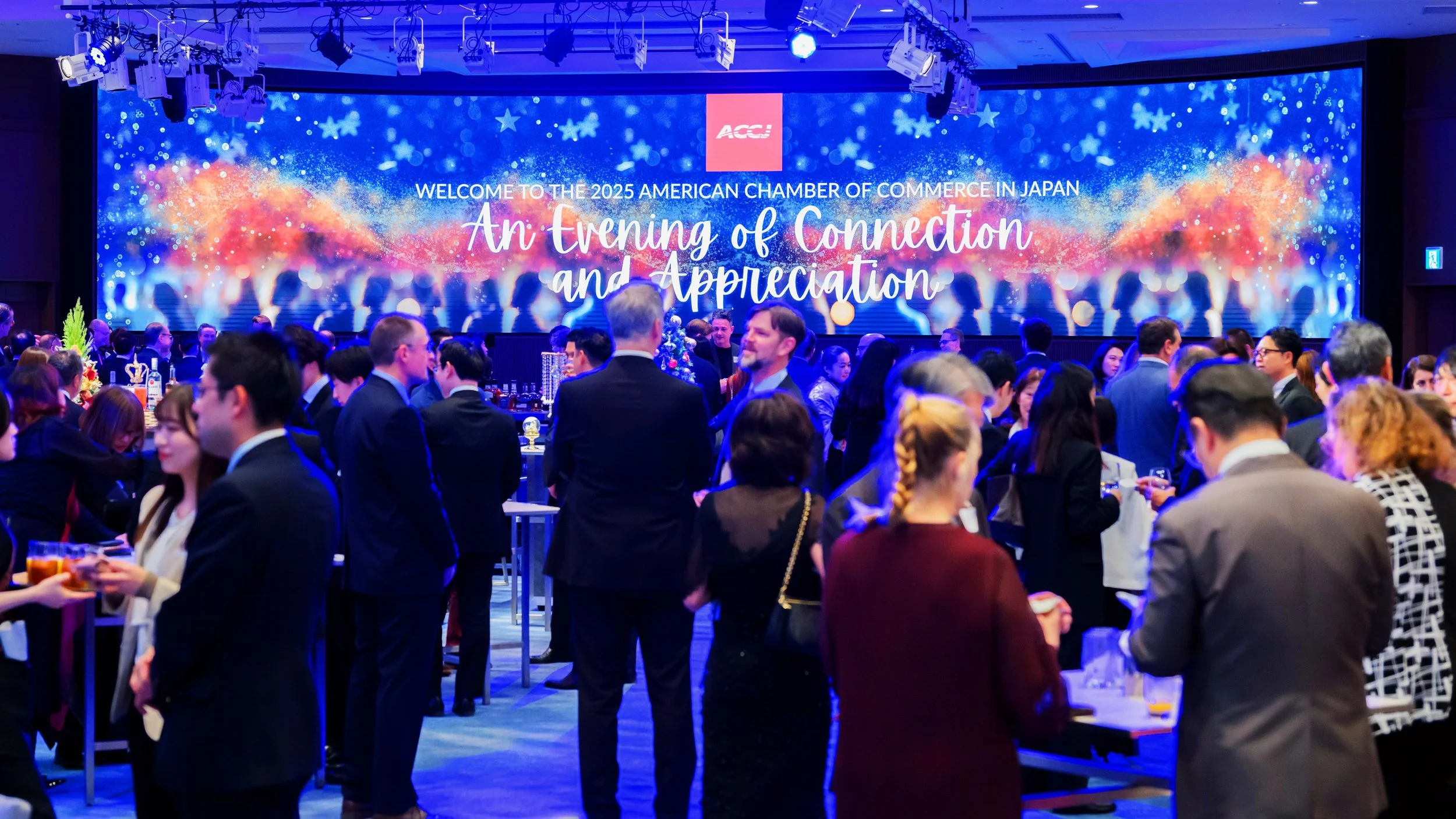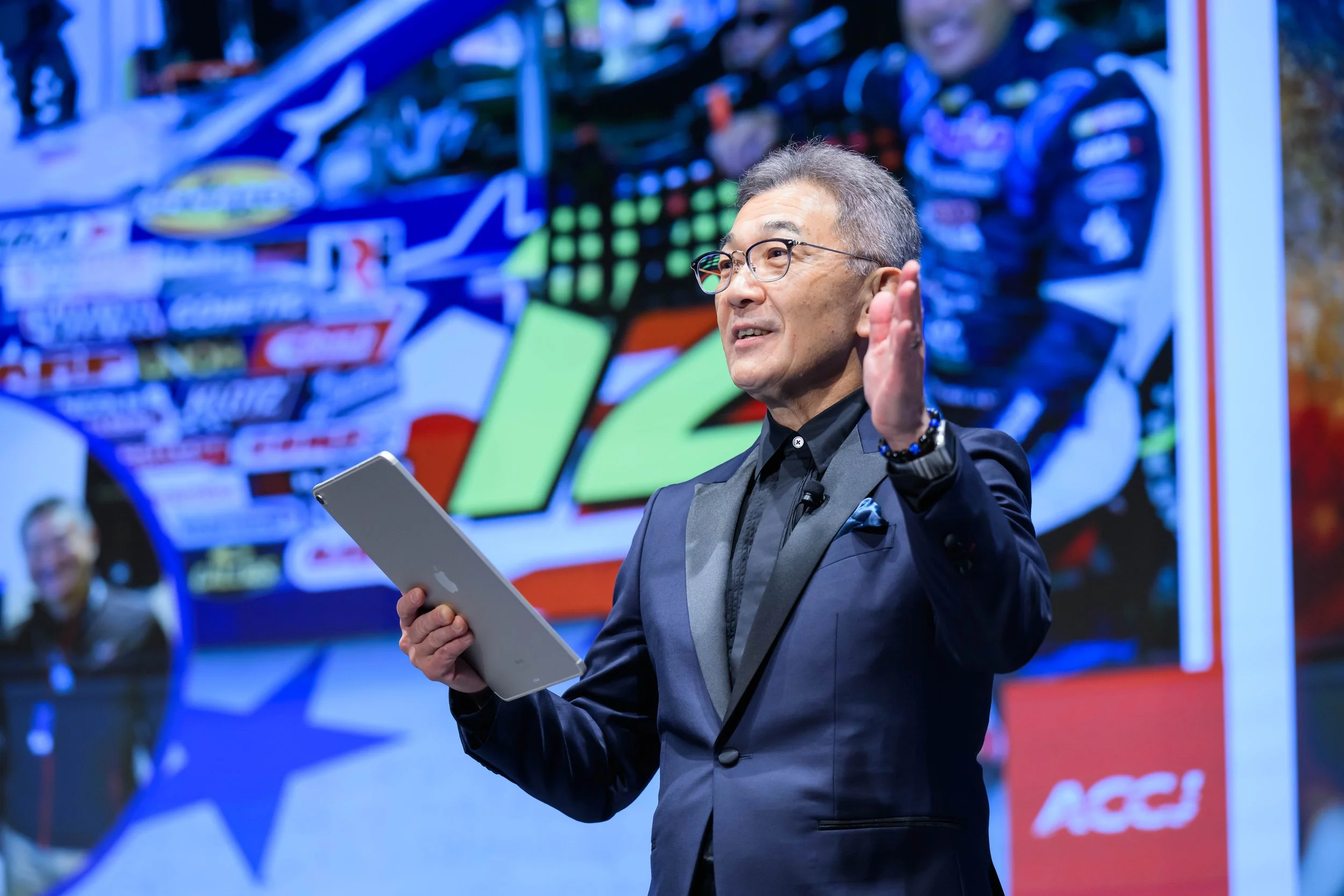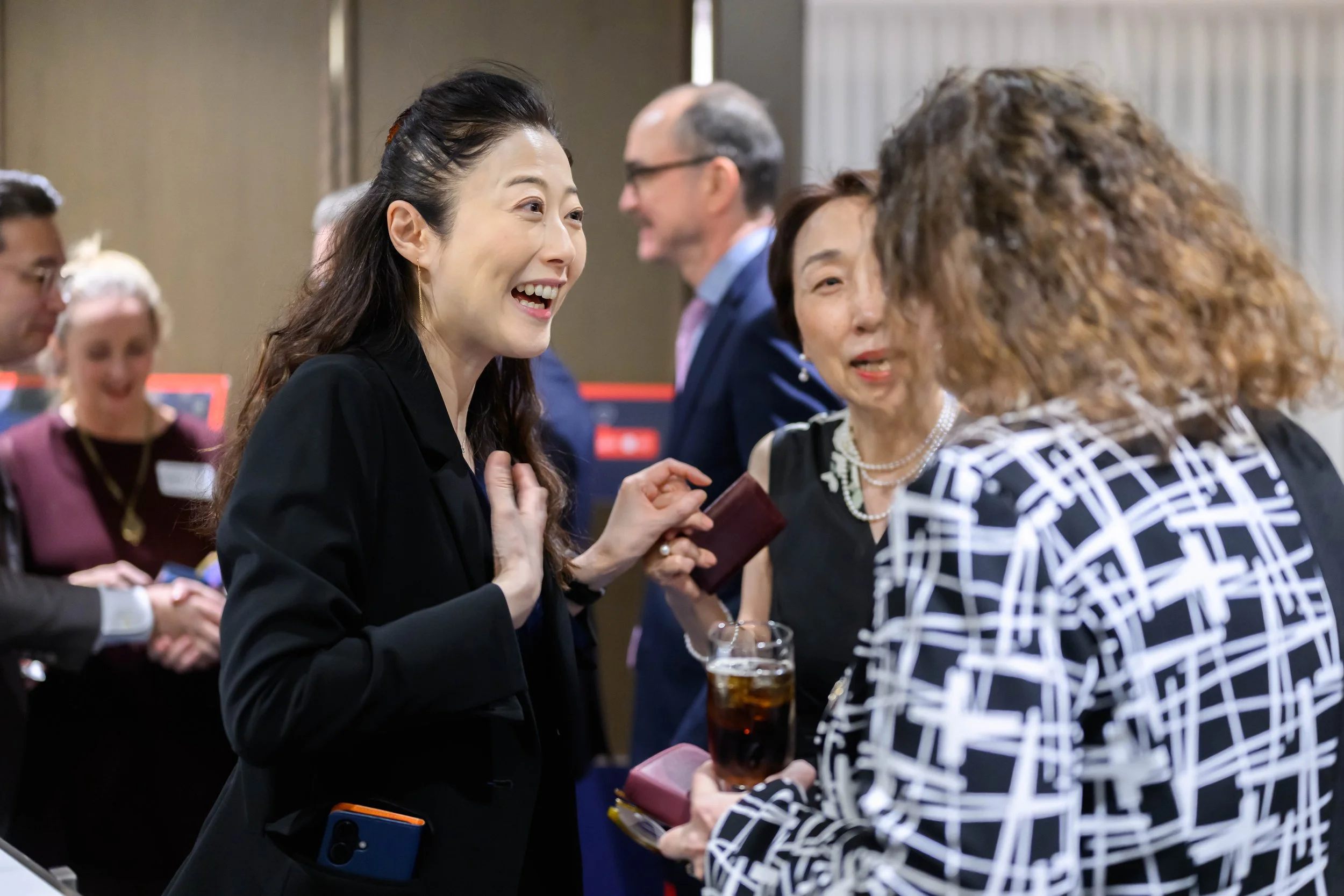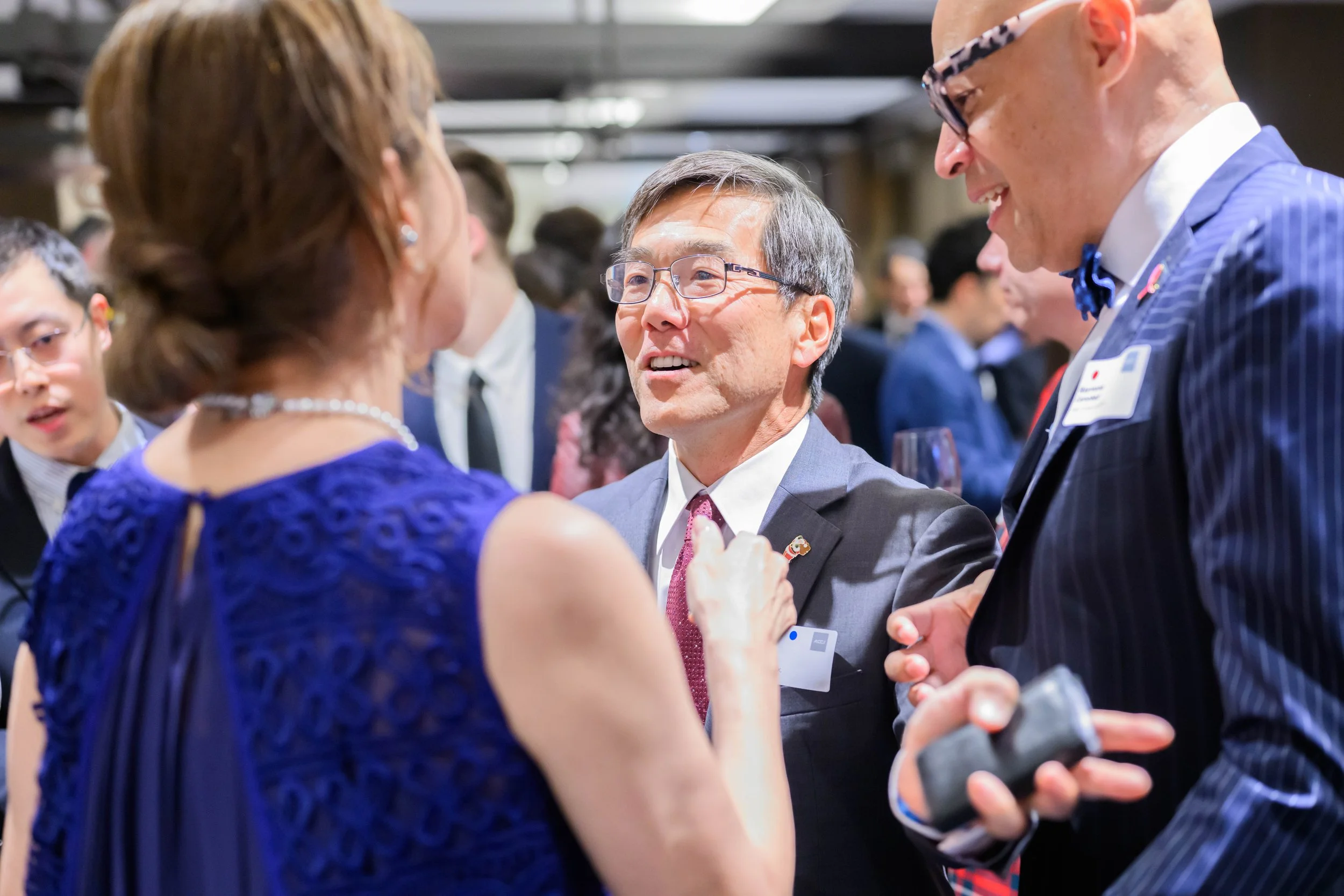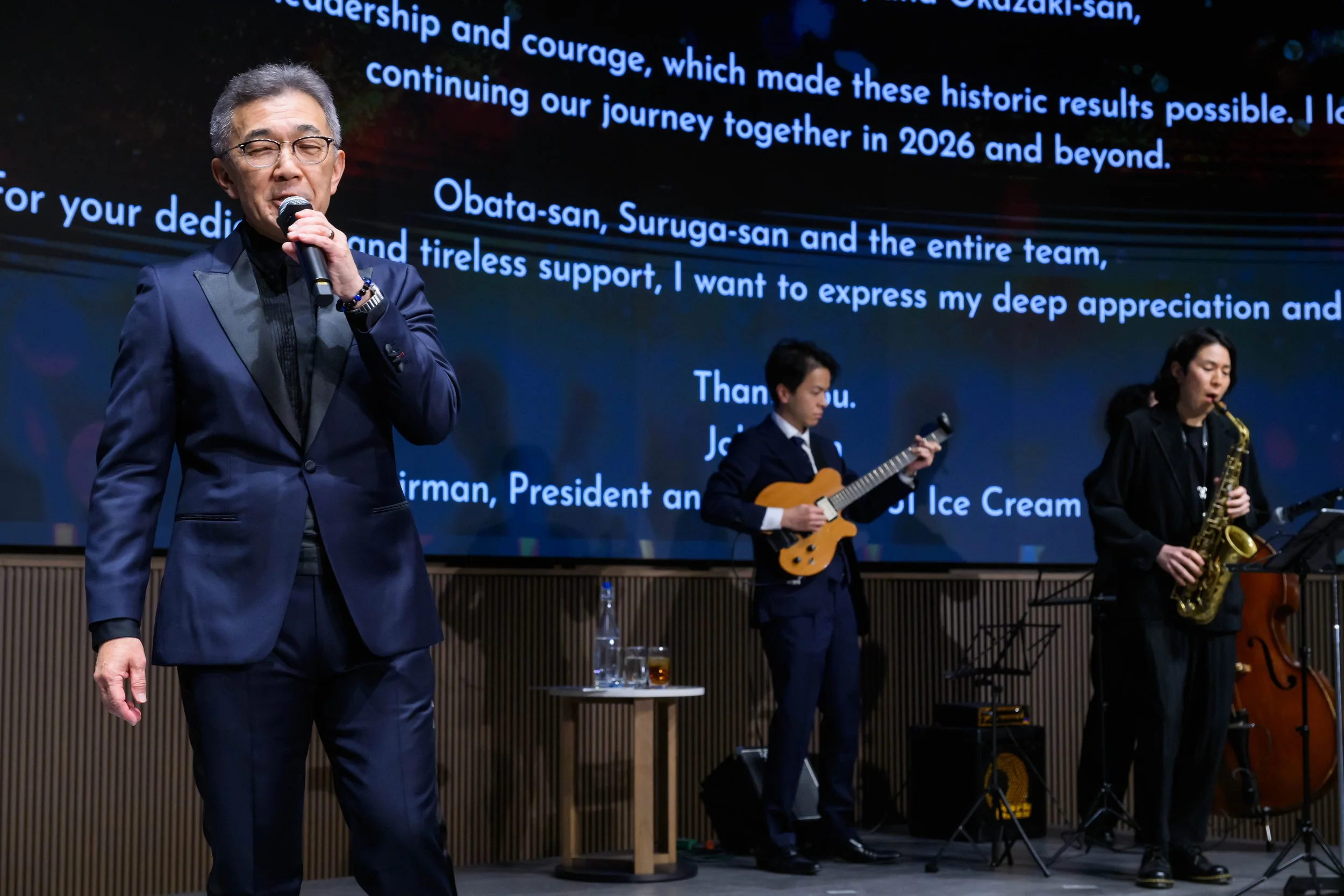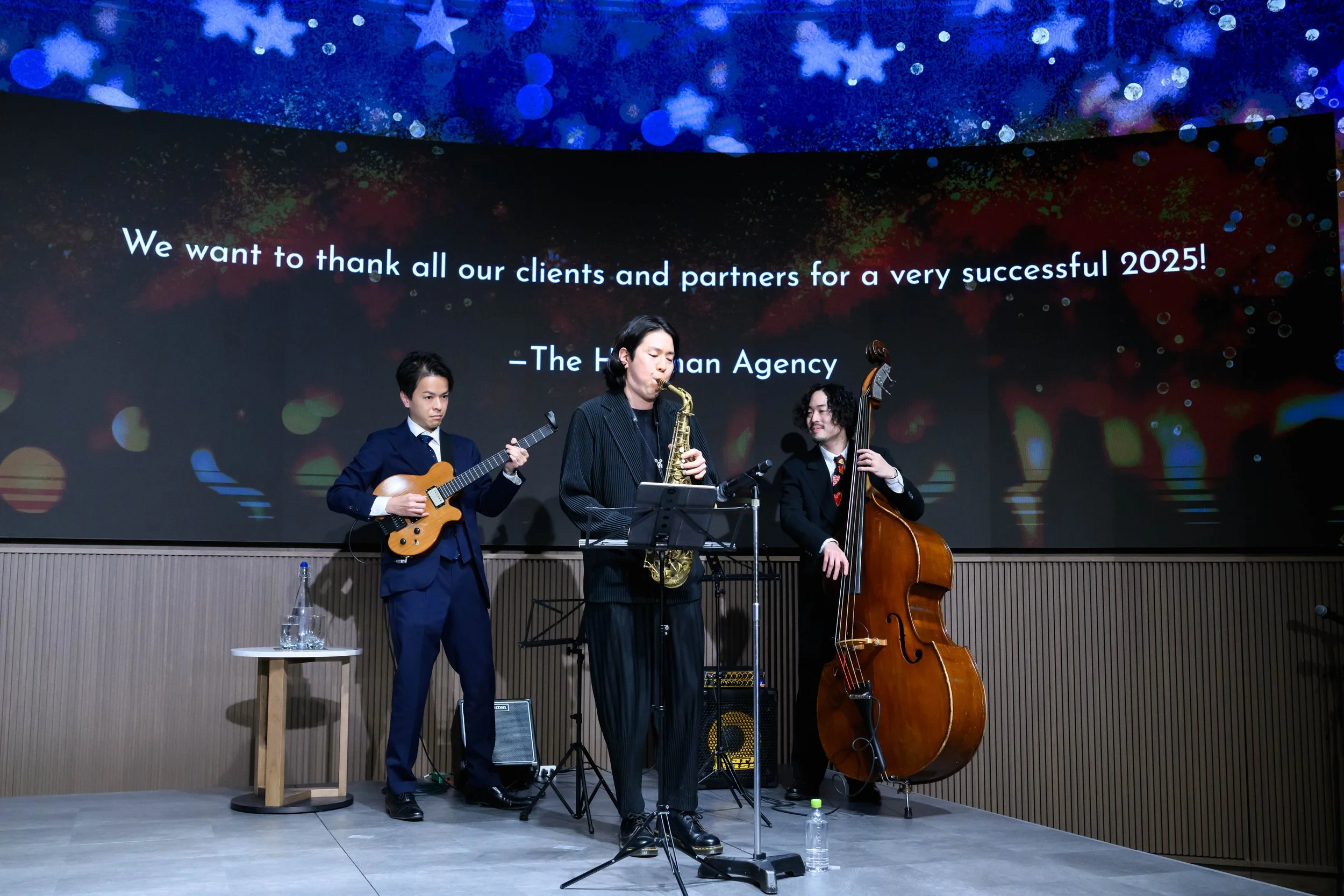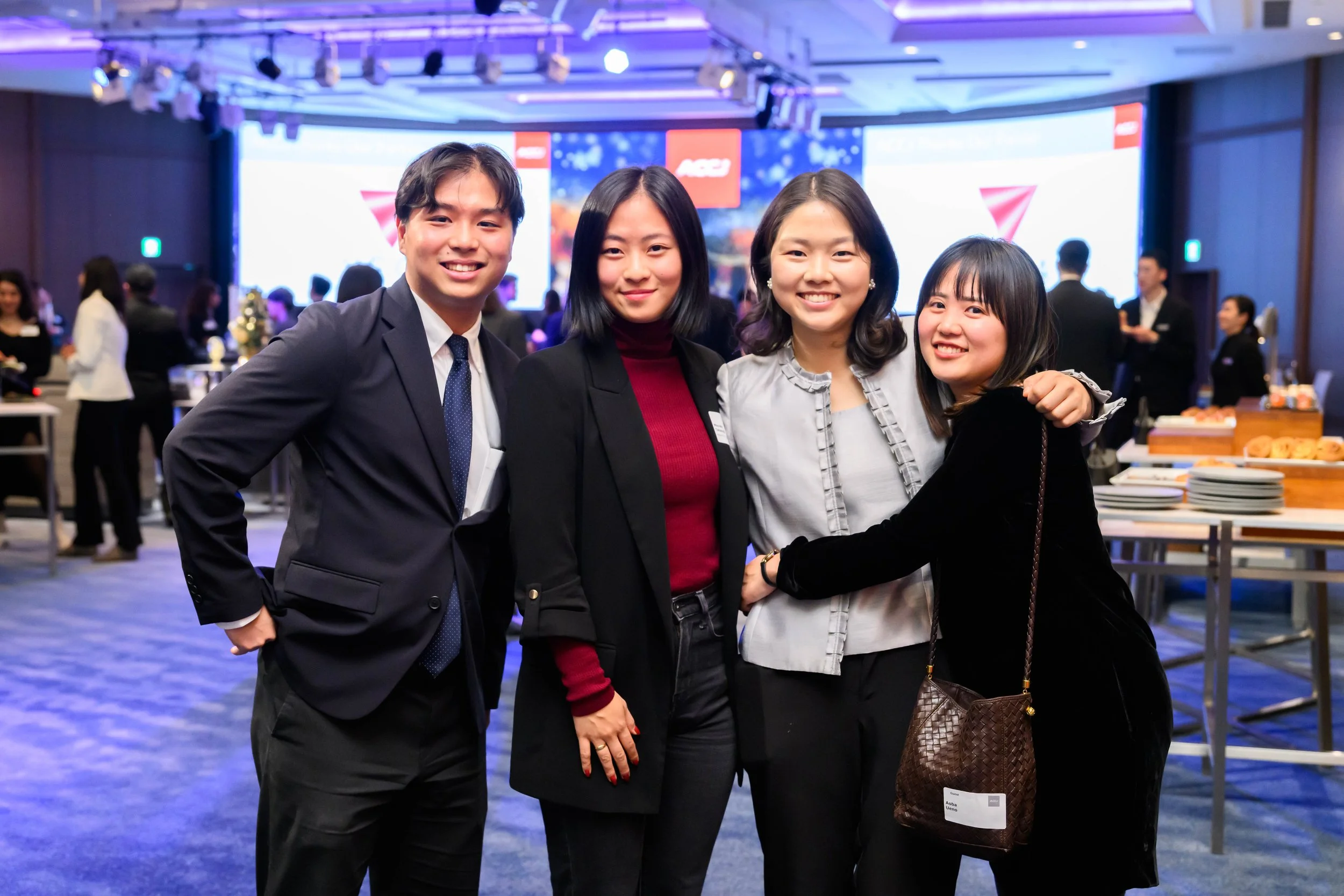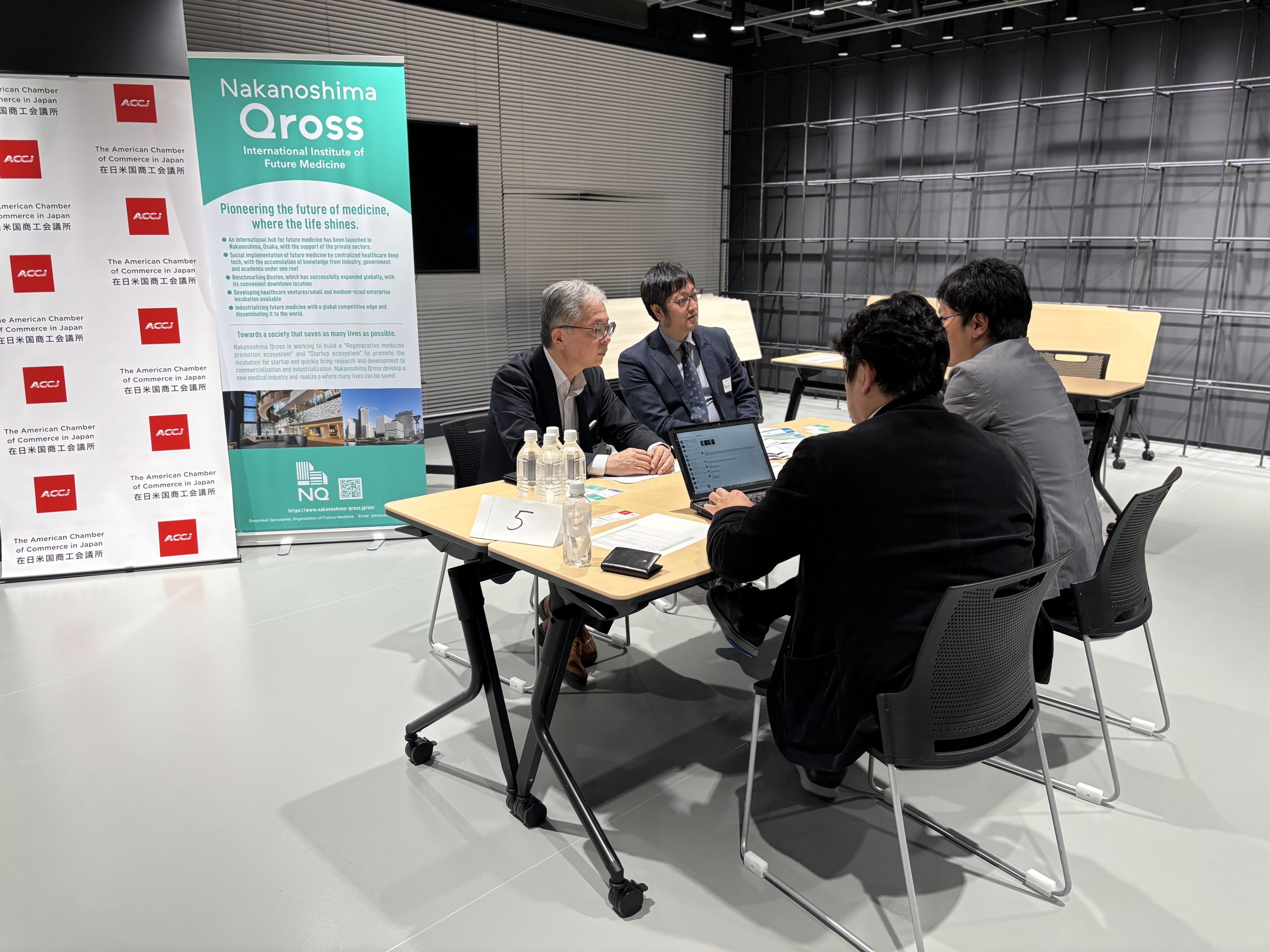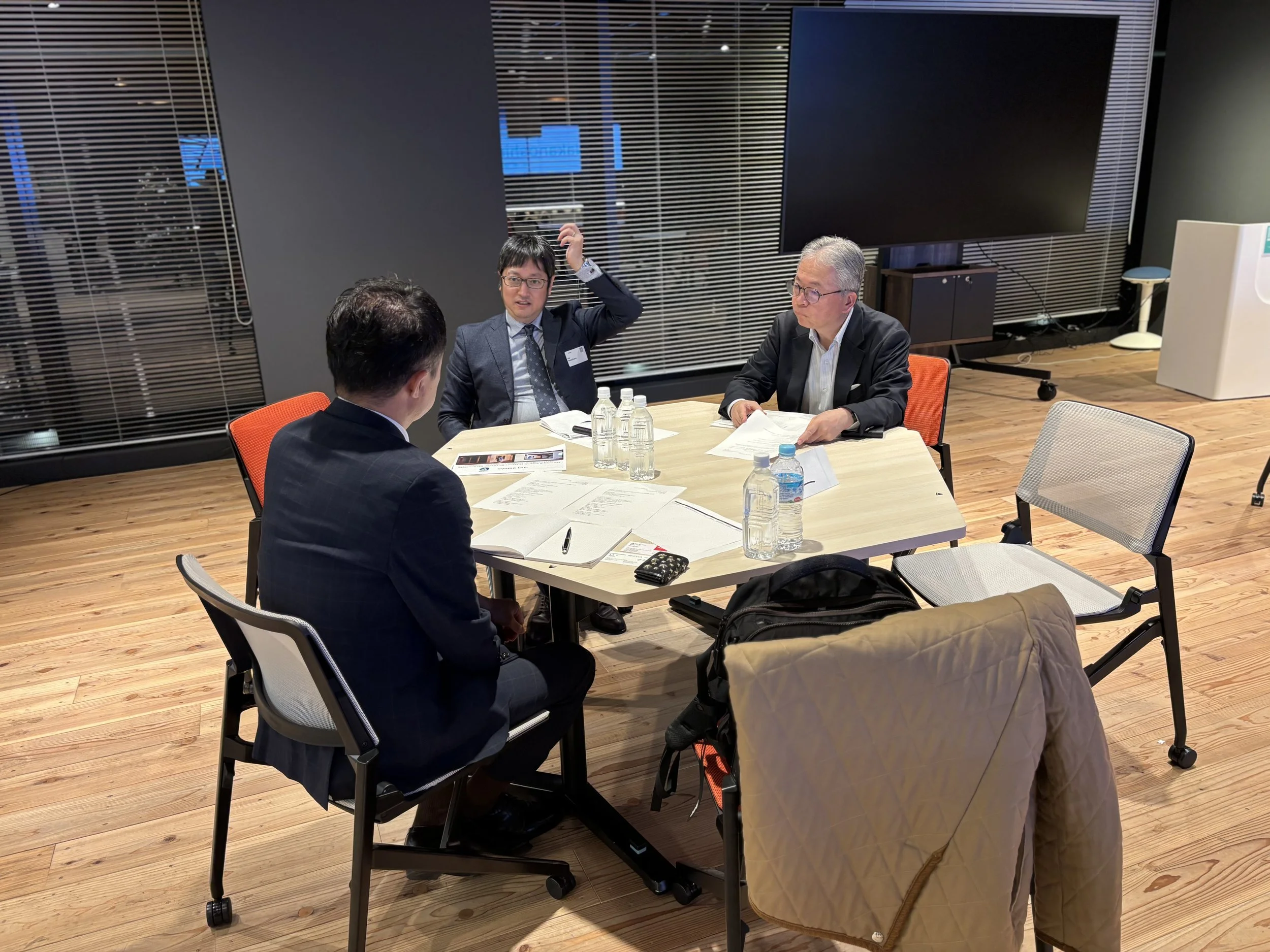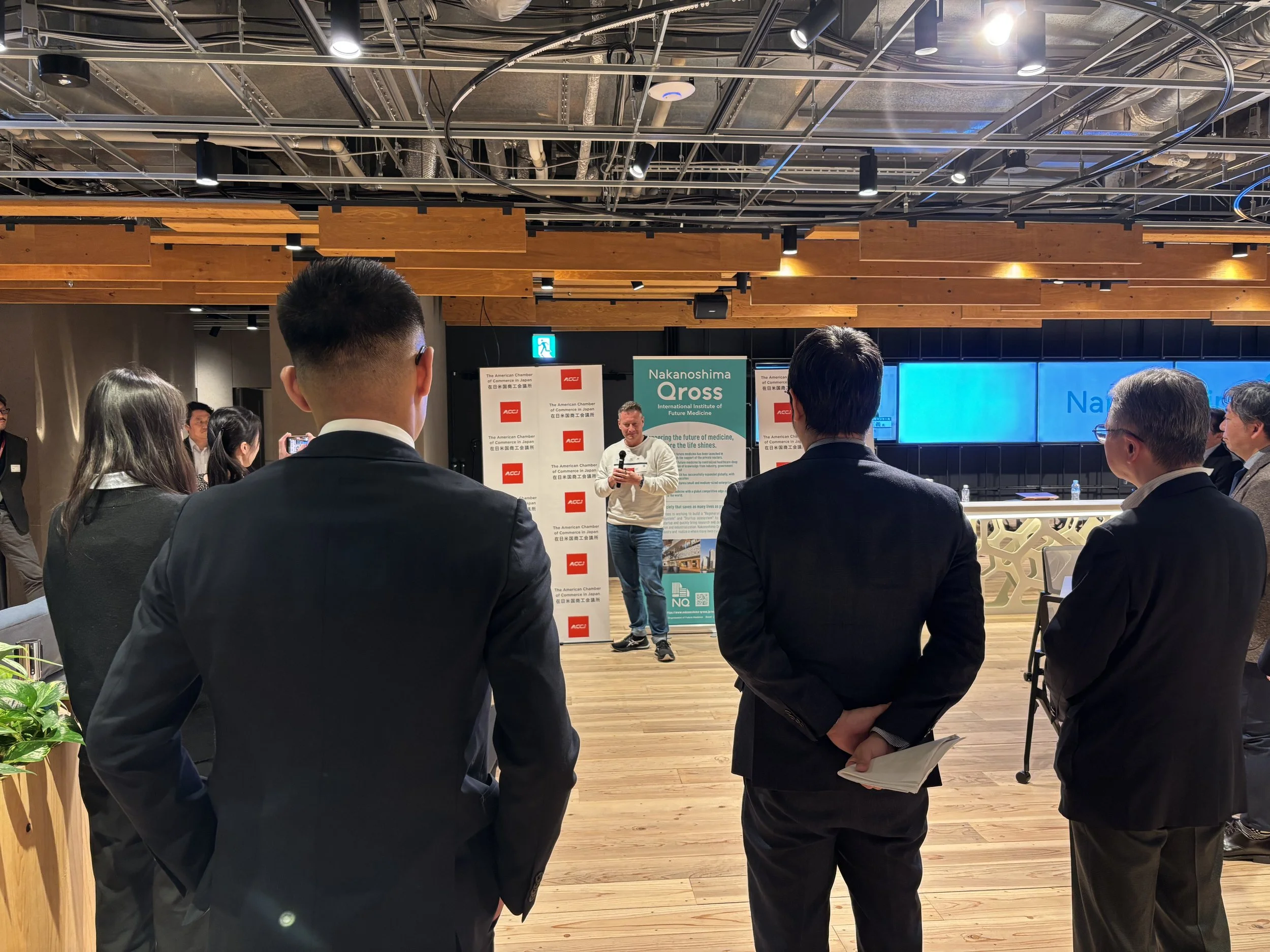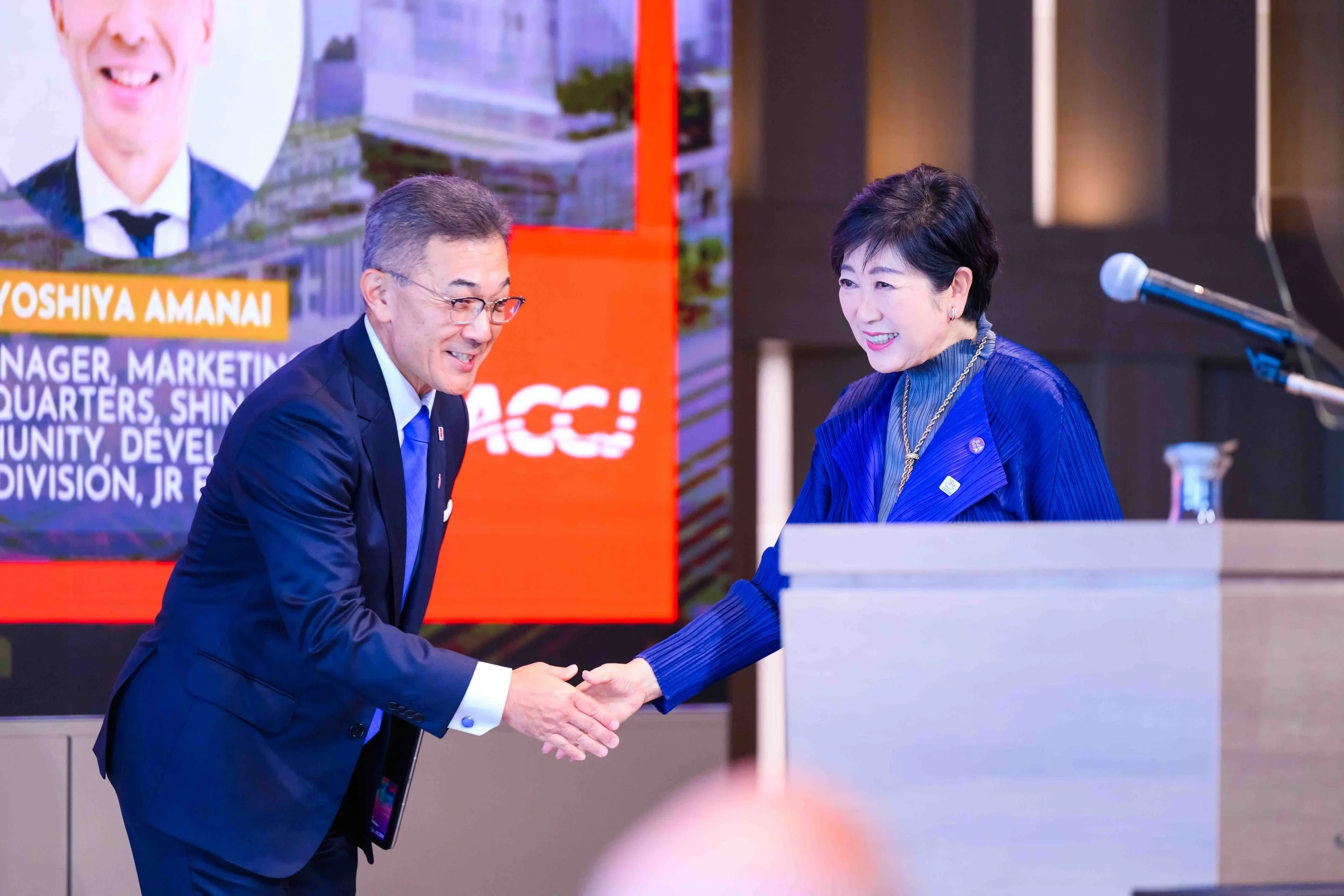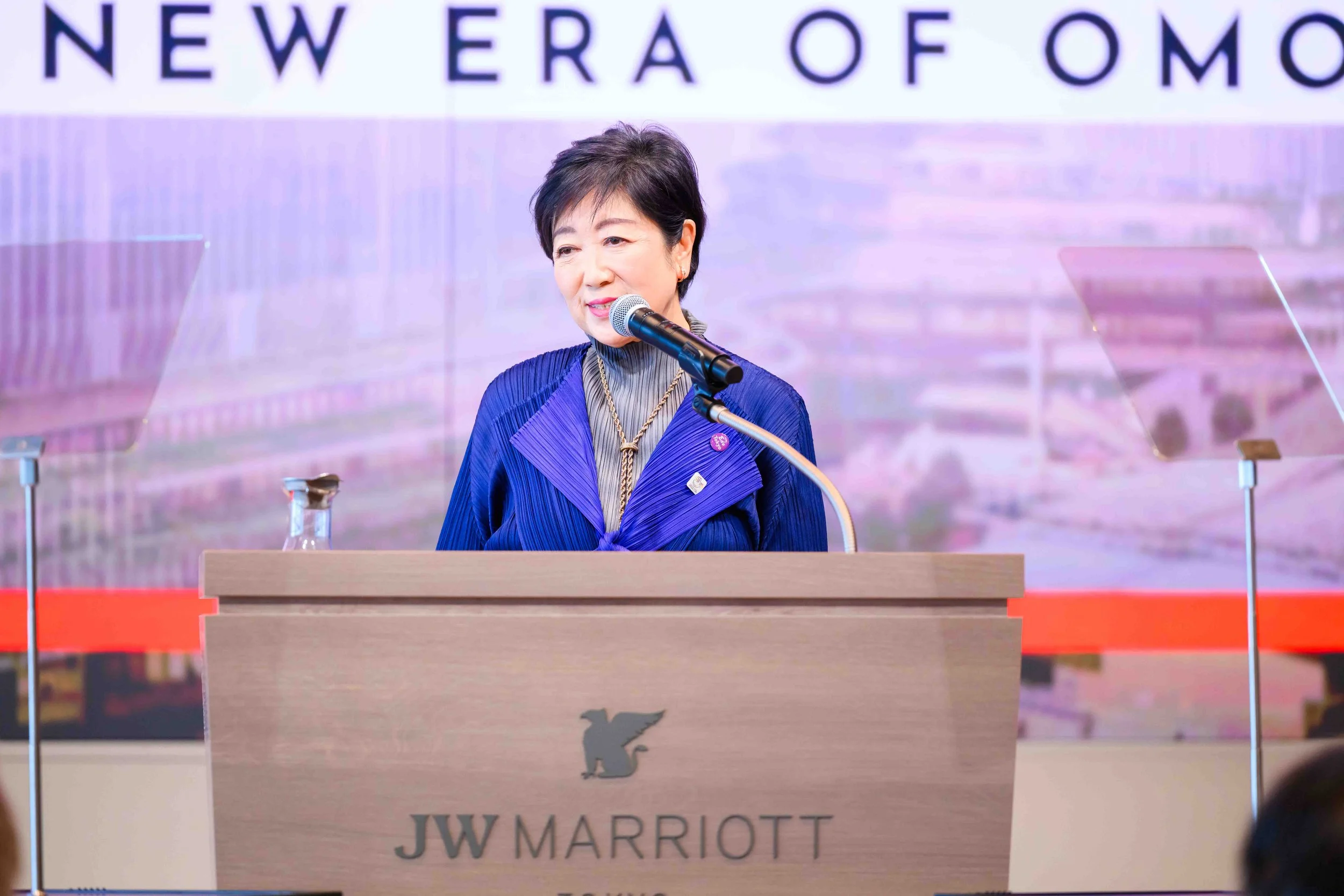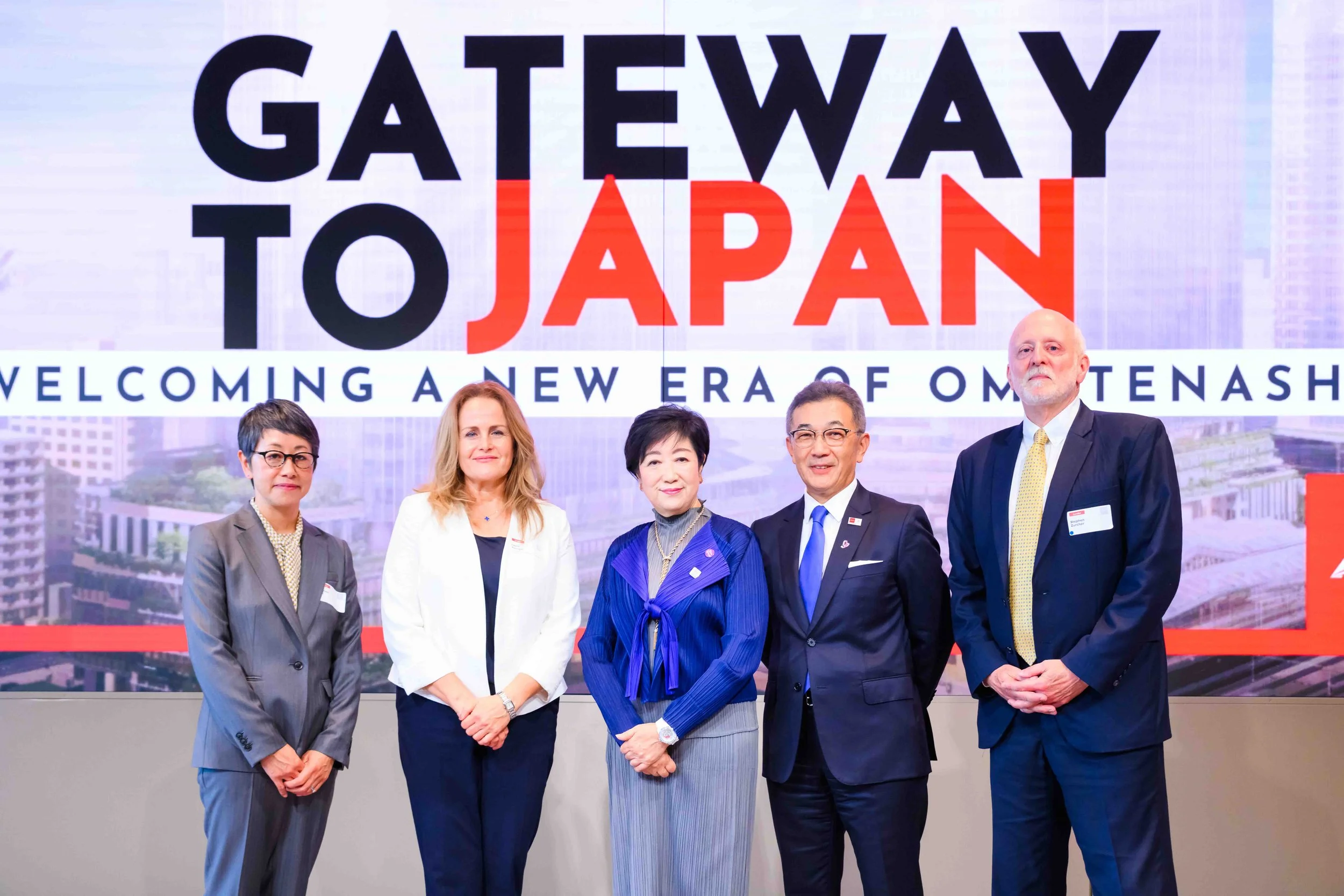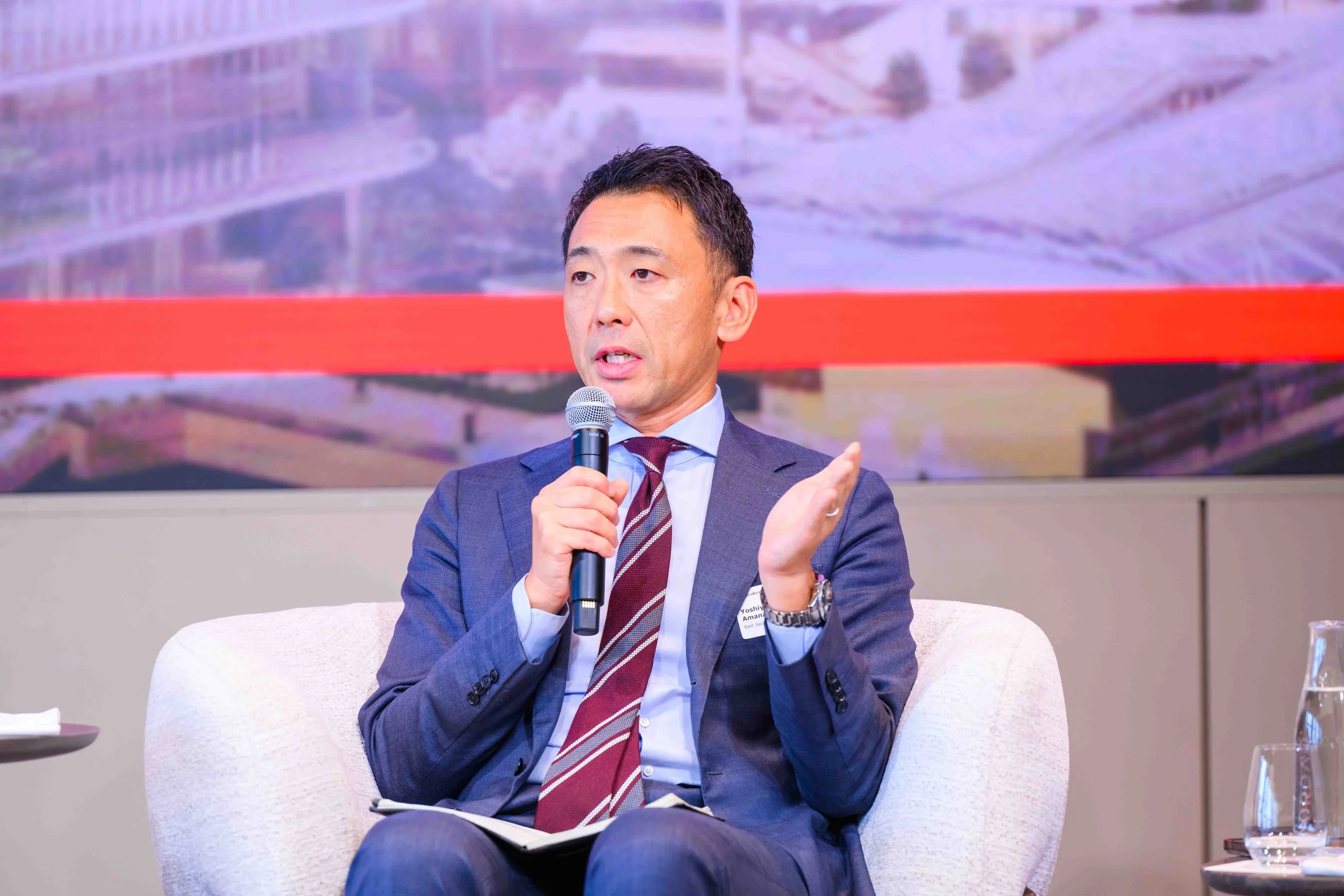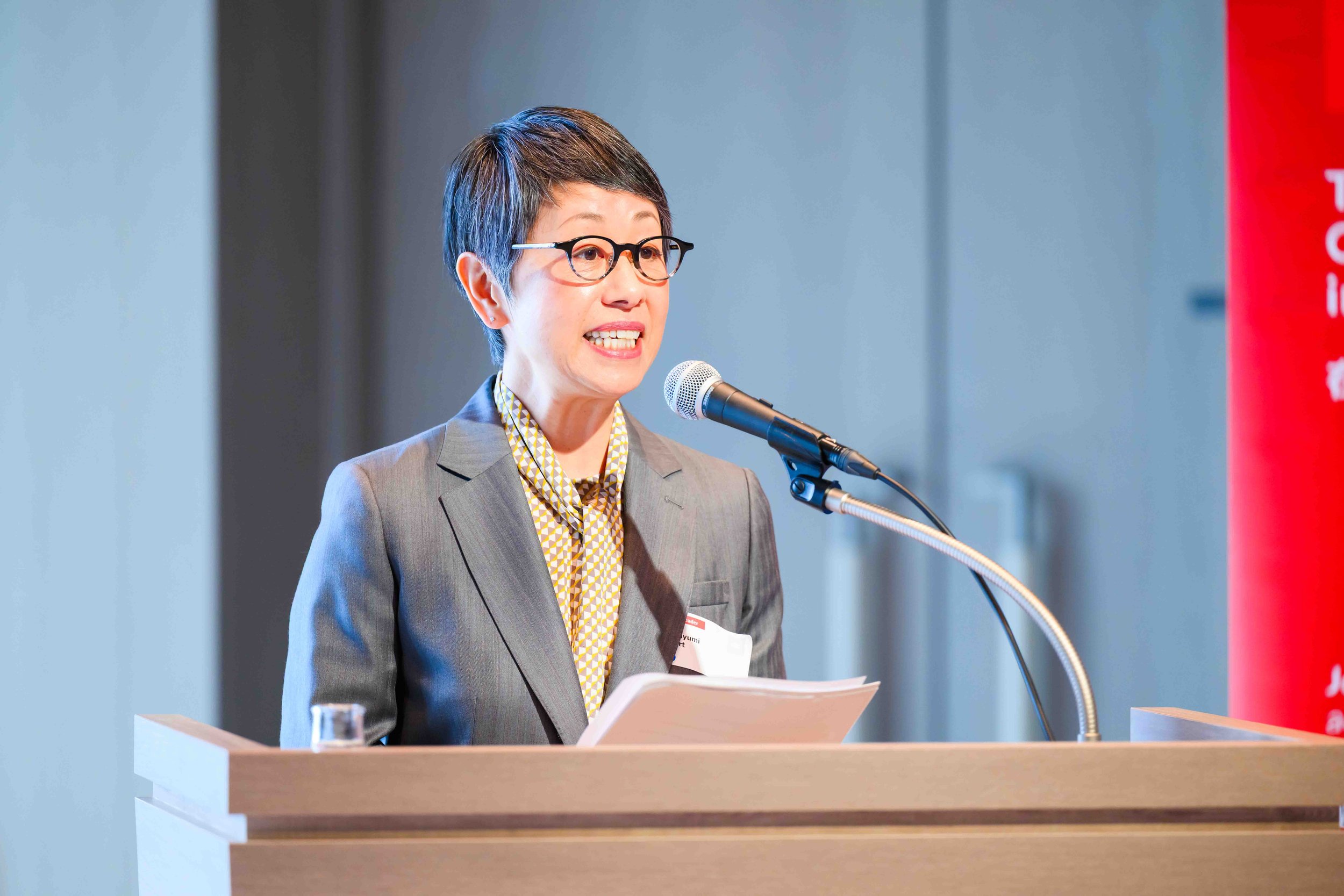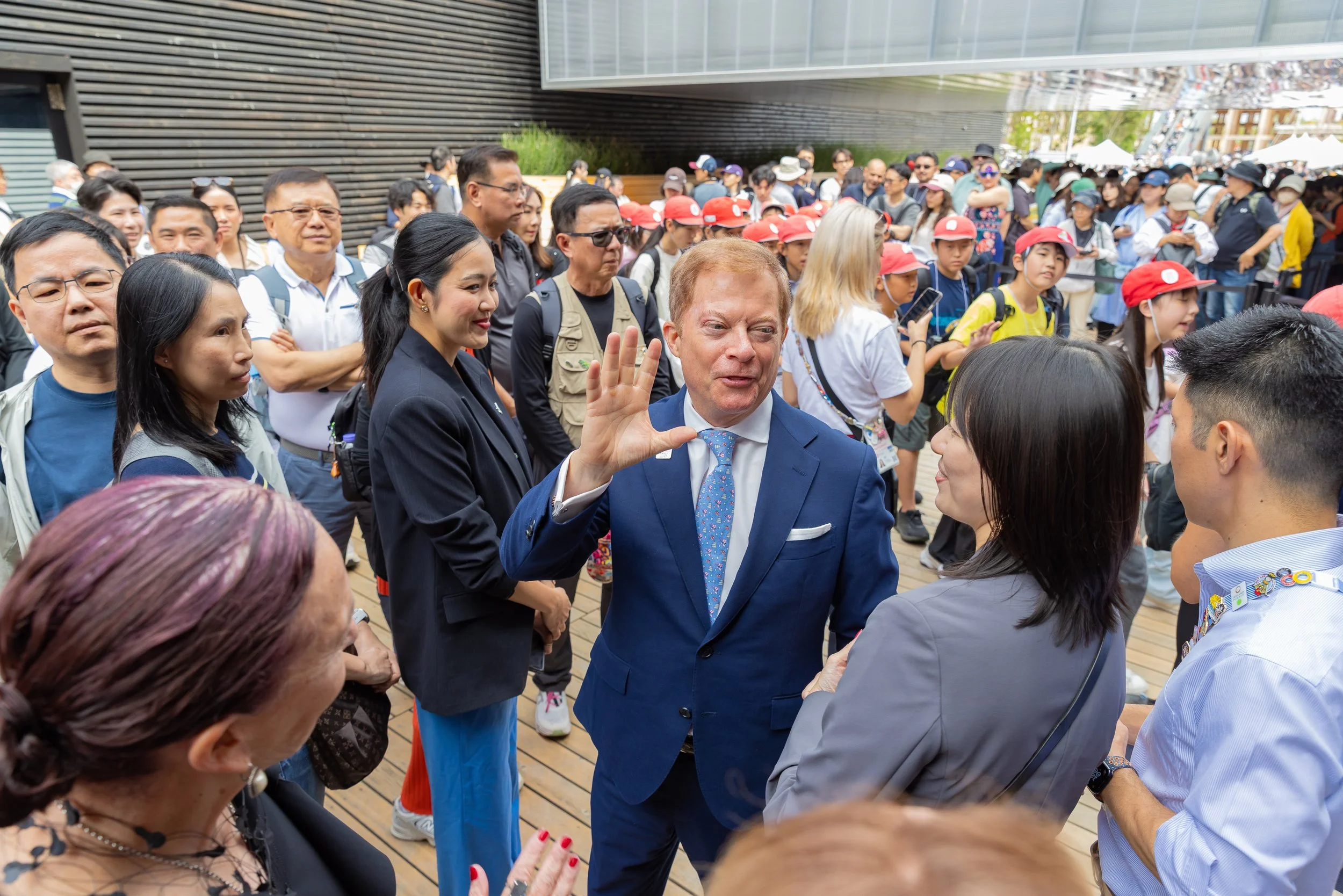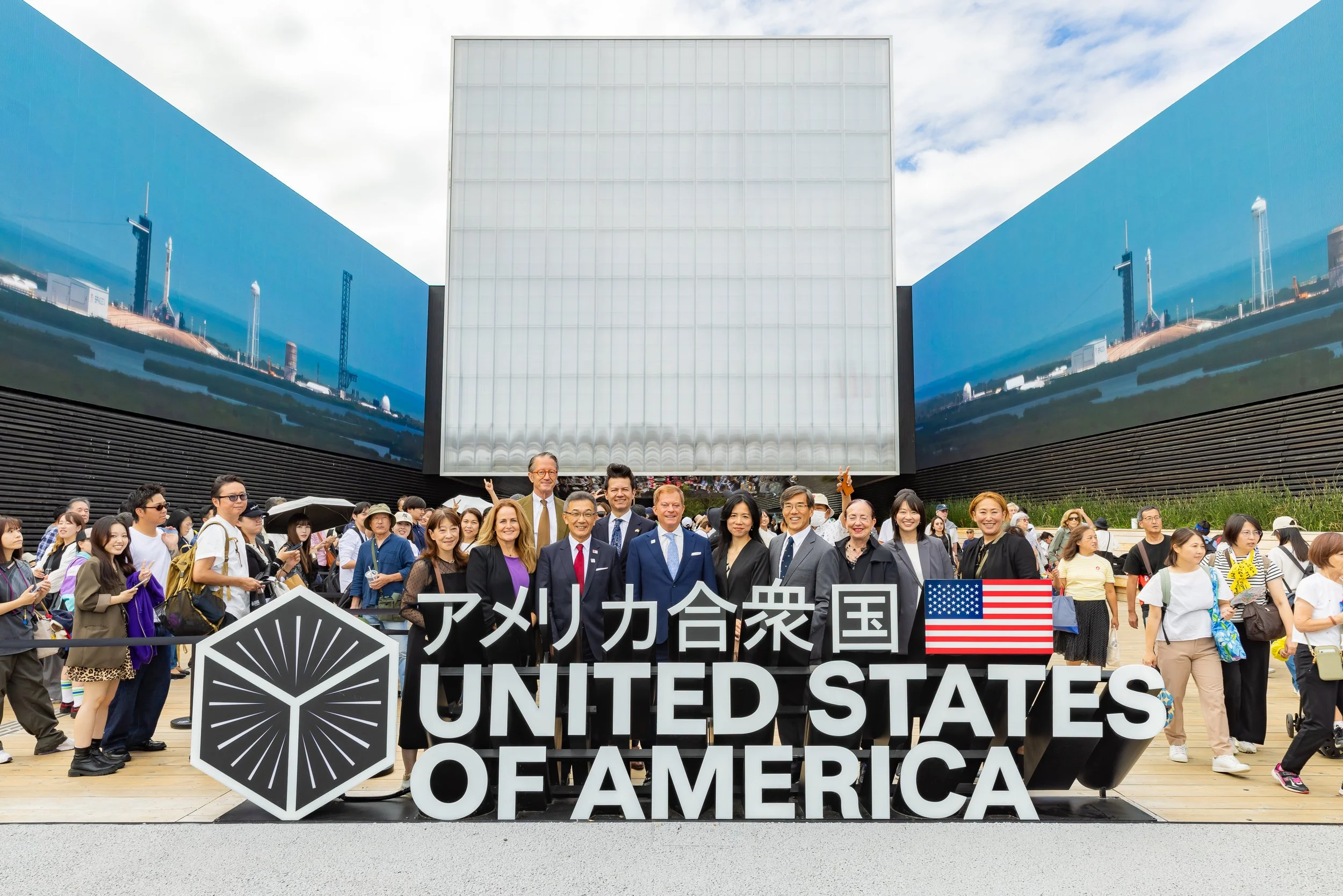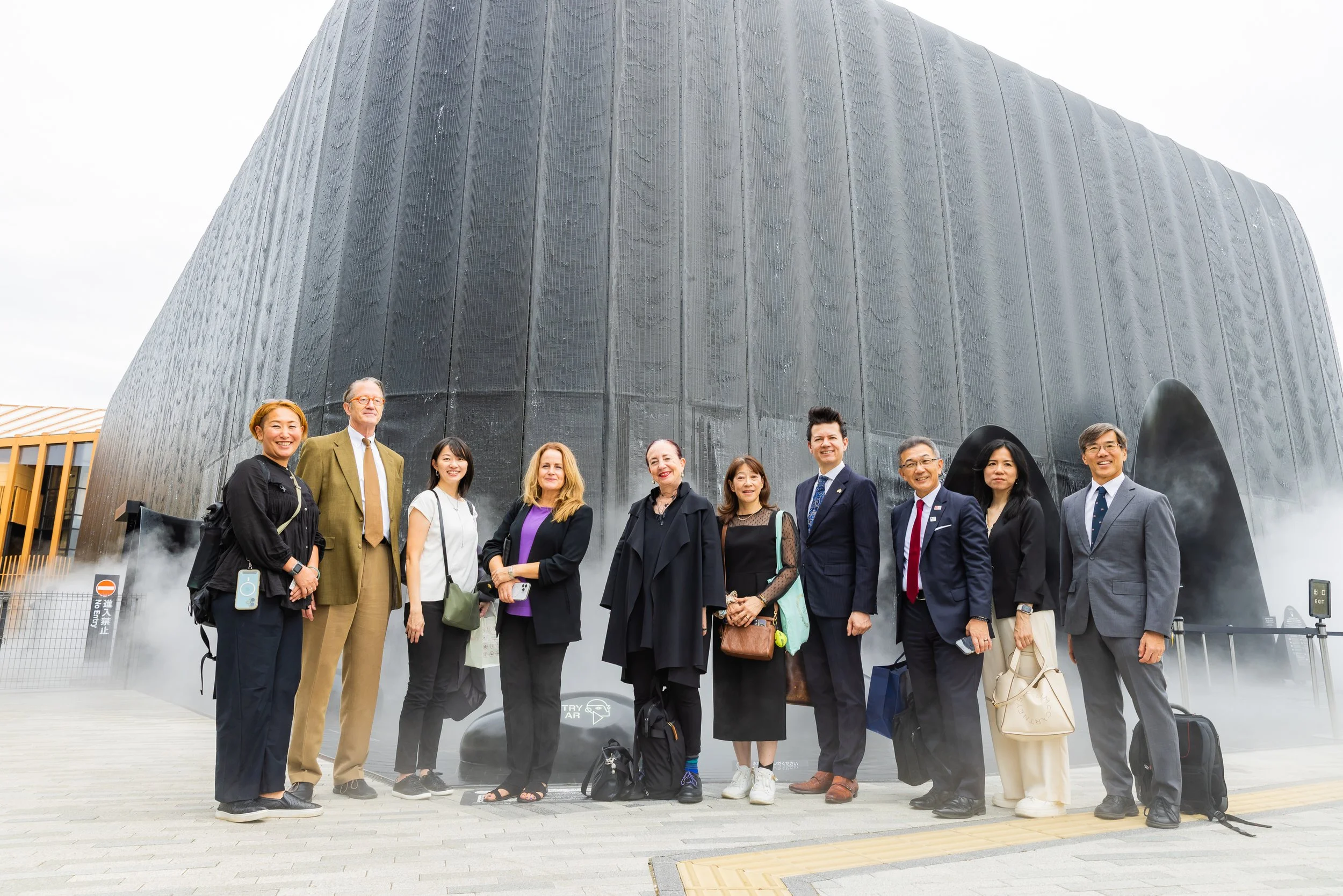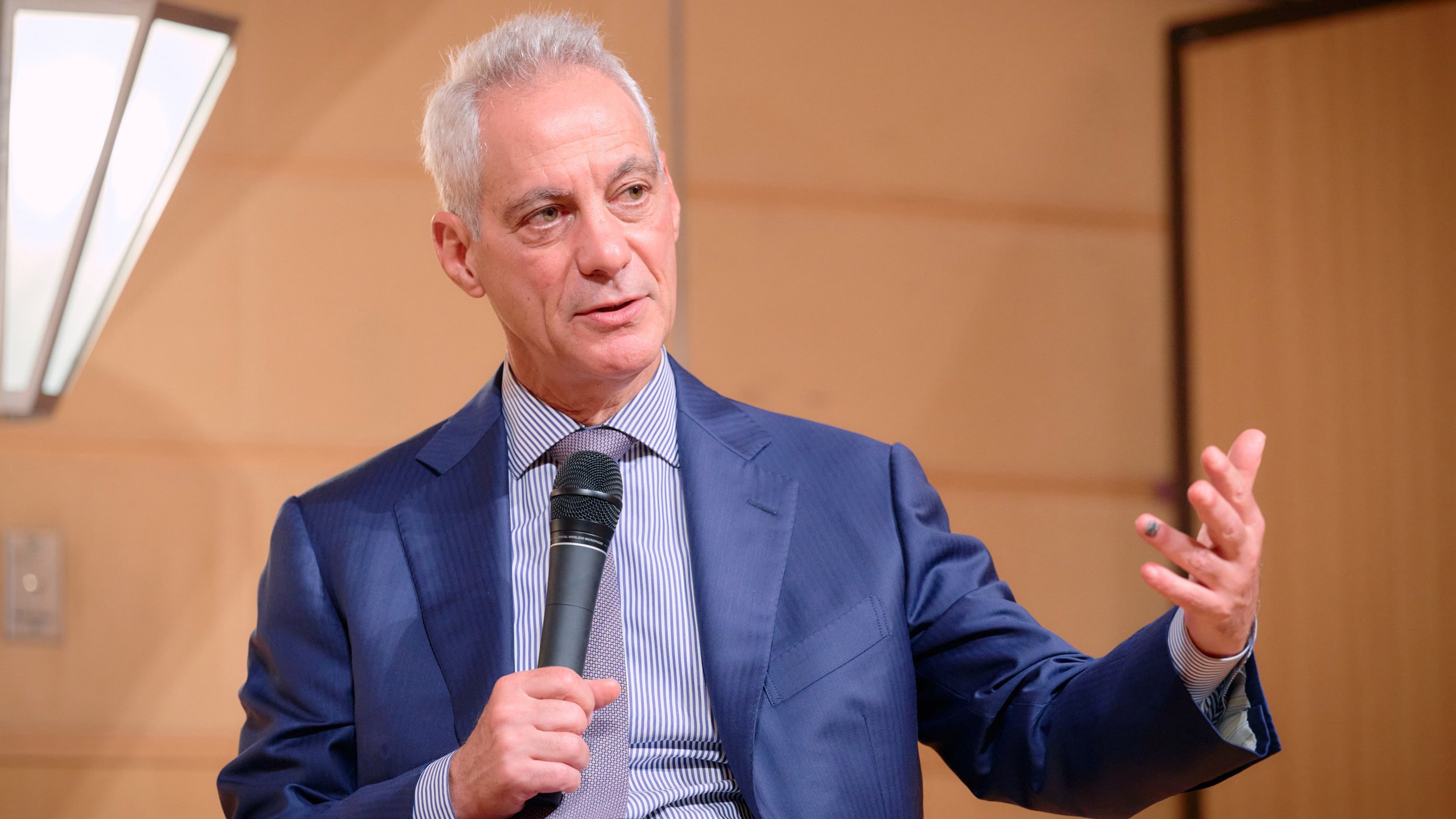An Evening of Connection and Appreciation
Members of the American Chamber of Commerce in Japan (ACCJ) and their guests gathered in the Hilton Tokyo’s Kiku Ballroom on December 11 to close out 2025 with its final signature event of the year.
The ACCJ closes out 2025 with a festive night of networking and honors.
Photos by Miki Kawaguchi/LIFE.14
Members of the American Chamber of Commerce in Japan (ACCJ) and their guests gathered in the Hilton Tokyo’s Kiku Ballroom on December 11 to close out 2025 with its final signature event of the year.
ACCJ President Victor Osumi took to the stage against a starry backdrop to welcome everyone to An Evening of Connection and Appreciation, a formal cocktail-style reception that brought together nearly 300 ACCJ members and guests.
“As we gather tonight, it is an opportunity to reflect on a year filled with remarkable achievements,” Osumi said. “It is a chance to reflect on a tremendous year of activity at the chamber, thanks to the support of our members’ collective efforts. We want to celebrate this spirit of collaboration and excellence.”
Next, to mark the incredible dedication of chamber members, ACCJ Vice President Arthur Mitchell joined Osumi on stage to present the 2025 ACCJ Leaders and Volunteers of the Year awards.
Also joining the festivities was 2025 ACCJ Person of the Year Ambassador William E. Grayson. He was honored for his leadership in advancing the US–Japan partnership as commissioner general of the USA Pavilion at Expo 2025 Osaka, Kansai.
“To receive this award from all of you brings an incredible amount of joy and happiness,” said Grayson, who shares more about the six-month experience of welcoming visitors to the USA Pavilion.
With formalities concluded, attendees indulged in the Hilton Tokyo’s culinary artistry and smooth jazz while making new connections for 2026.
Sharpening the Story
The ACCJ Healthcare x Digital (HxD) initiative reached a new milestone on December 2 with its first-ever exclusive mentorship event for healthcare startups at Nakanoshima Qross in Osaka.
HxD Mentor Day helps healthcare startups perfect their pitch for 2026.
The ACCJ Healthcare x Digital (HxD) initiative reached a new milestone on December 2 with its first-ever exclusive mentorship event for healthcare startups at Nakanoshima Qross in Osaka. Instead of pitching onstage, founders spent the afternoon strengthening their narratives—then pressure-testing them in small-group mentoring sessions with industry experts.
The program opened with a workshop led by Christian Boettcher, managing partner at Takaraya Capital and formerly a senior partner and APAC sector leader consulting partner for healthcare and life sciences at EY Strategy & Consulting. He was joined remotely by Kristin Chen, a Silicon Valley product leader, fractional chief executive (CxO), and adviser with more than 15 years’ experience at LinkedIn, Twitch, Pinterest, and multiple startups.
Their joint message? A compelling pitch starts with clarity, discipline, and a strong grasp of what investors listen for in the first minute.
Expanding the Model
HxD is an initiative team within the ACCJ–Kansai chapter’s Healthcare Committee. It connects academia, startups, corporates, and government around three themes:
- The hospital of the future
- Patient data empowerment
- Urban–rural healthcare equity
Since 2020, HxD has hosted pitch competitions and ideathons; the December Mentor Day introduced a more intimate format designed to help founders refine their thinking ahead of the 2026 HxD Pitch Competition.
After the workshop, founders rotated through two rounds of 30-minute sessions with mentors from organizations including Eli Lilly, AstraZeneca, EY, IQVIA, K&L Gates, Innovation Dojo, and Zimmer Biomet. The conversations were candid and practical, focusing on communicating value, understanding customers, and positioning within the healthcare ecosystem.
Christian’s Essentials: Focus Your Story
Boettcher began with simple, universal guidelines:
- One message per slide
- Readable font sizes
- Minimal, intentional use of color
From there, he walked through several elements investors expect to see. The first is the founding team—why they are qualified to address the problem and what insight or experience led them to the idea.
Next comes the problem definition. Founders often jump into technology, he noted, without clearly explaining the pain point or who experiences it. “What is the problem itself? And why does it matter?”
Only after establishing the problem should founders propose their solution and what differentiates it. He urged startups to evaluate the “graveyards” where companies that attempted similar ideas and stalled—and understand what went wrong.
Boettcher also highlighted the importance of financial clarity. Even non-financial founders must be able to explain revenue streams, cost structures, runway, and the logic behind market estimates. Overstated markets or vague assumptions erode credibility quickly.
Finally, he emphasized context awareness. With artificial intelligence (AI) accelerating innovation and policy changes influencing healthcare, strong founders show they understand how broader shifts affect their strategy.
Kristin’s First 60 Seconds: What Investors Listen For
Chen offered an investor’s perspective, noting that expectations have risen. “Venture capitalists now want retention, growth, and monetization signals early,” she said.
Sharing a four-pillar framework for evaluating a pitch, Chen stressed that she listens for all four within the first 60 seconds:
- A real, enduring problem
- A meaningful or growing market
- A scalable, tech-driven advantage
- A credible path to revenue
“If these elements aren’t clear within a minute, it’s hard for an investor to stay engaged,” she said.
To make the problem tangible, Chen urged founders to reference user research and analytics: interviews, surveys, user-generated content, and existing studies. Specific data points or quotes help quantify severity and show that founders understand the people they aim to serve.
She also recommended preparing two deck versions: a concise one for live delivery and a self-contained one for investors reviewing the pitch independently.
Pain, Markets, and Communication
During the Q&A session, a mentor asked how to quantify customer pain and how narrowly to define the target market. Chen suggested starting with an ideal customer profile and using qualitative and quantitative research to validate who feels the pain most. Boettcher offered a healthcare example: Japan’s diabetes-related hospitalizations can be quantified not only in medical costs but also lost productivity.
A biotech founder asked how to pitch when pharmaceutical companies are the paying customers, but patients benefit most. Boettcher explained that in areas like AI-driven drug discovery, startups must map a multilayered market—including pharma, biotechs, and government programs. Chen added that founders should be explicit about the sales cycle, decision-makers, and associated risks.
Another question focused on Japan-based founders pitching in English while simultaneously managing verbal, visual, and nonverbal communication. Chen emphasized practice, tailoring the story to each investor, and developing “executive presence.” Early-stage investors, she said, often bet on the founder as much as the idea. “If you don’t believe in yourself, how do you expect others to believe in you?”
Boettcher echoed the importance of rapport. Even strong products struggle if founders cannot communicate confidently and connect with the audience.
Platform for 2026 and Beyond
After the workshop, the mentoring sessions brought theory into practice. Founders and mentors sat together to refine slides, discuss specific markets, and explore potential collaboration pathways.
As the first HxD Mentor Day, the gathering added a valuable new dimension to HxD’s ongoing efforts to support digital health innovation across Japan. With the next major pitch opportunity coming in February, participating founders left with clearer stories, stronger decks, and a better understanding of what resonates with investors, especially in that critical first minute.
In a healthcare environment where technology and expectations are evolving quickly, these communication skills are becoming as essential as the innovations themselves.
Gateway to Japan
As arrivals boom, can the country’s hospitality industry keep pace through a new era of omotenashi? That was the question at the center of an ACCJ event hosted on October 8, featuring Tokyo Governor Yuriko Koike.
As arrivals boom, can the country’s hospitality industry keep pace through a new era of omotenashi?
Photos Miki Kawaguchi/LIFE.14
From left: Stephen Zurcher, Christopher Clark, Yoshiya Amanai, and Tadayuki Hara
Bullet trains slicing past a snow-covered Mount Fuji. Real-life anime beneath the neon lights of Akihabara. A fleeting glimpse of geisha in Kyoto’s lantern-lit alleys. For millions of tourists around the world, it’s scenes like these that put Japan at the top of their travel list.
Demand for such experiences has surged since the country reopened its borders in October 2022, after nearly two and a half years of pandemic-imposed isolation. This year alone, more than 35.5 million inbound tourists arrived through October, shattering the previous annual record set in 2019 of 31.88 million with two months to go. Japan is well on its way to hitting the government’s target of 60 million by 2030.
With visitors comes money. Inbound tourism is now Japan’s second-largest export industry after autos, and achieving the 2030 goal would see an injection of ¥15 trillion ($100 billion) into the economy—equal to the nation’s annual defense spending at nearly two percent of gross domestic product.
This potential—and how to harness it—was at the center of an event at the new JW Marriott Tokyo on
October 8, hosted by the American Chamber of Commerce in Japan (ACCJ) Tourism and Hospitality Committee and organized by Vice-chair Mayumi Nakamura Birt, who also served as emcee.
Gateway to Japan
Tokyo Governor Yuriko Koike delivered the keynote, sharing exciting plans that stretch even farther and promise to elevate all aspects of tourism, going beyond sightseeing to business, education, cultural exchange, events, investment, and innovation.
“We have formulated the Tokyo 2050 Strategy as a compass guiding us to the future,” she explained, speaking in a milestone year when New York City and Tokyo celebrate their 65th anniversary as sister cities. “The driving force harnessing the strength of the city is people. And that is why Tokyo is advancing people-focused initiatives. Notably, in response to globalization, we are bolstering efforts to build an environment enabling younger generations to play an active role in the world. Through our investment in people who underpin socioeconomic activities, we will enhance our hospitality and guide the further growth of Tokyo and the rest of Japan.”
Tokyo ranked third behind New York and London in the 2024 Global Power City Index, compiled by the Mori Memorial Foundation’s Institute for Urban Strategies. First published in 2008, the annual study ranks major cities around the world in terms of magnetism—their power to attract creative individuals and enterprises—according to 70 indicators across six functions:
- Economy
- Research and development
- Cultural interaction
- Livability
- Environment
- Accessibility
Thanks to improvements in research and development, cultural interaction, livability, and accessibility, Tokyo significantly increased its score from the previous year, closing the gap on second-place New York. In the study’s actor evaluation—how a city is perceived by specific groups of people—Tokyo ranked second among tourists.
But there’s still room for improvement. After-dark activities is one area highlighted by Koike.
“We are also focusing on upgrading our nighttime tourism. Projection mapping on the wall of the Tokyo Metropolitan Government building holds a Guinness record and has attracted over 900,000 spectators,” said the governor.
The event’s panel of experts, who discussed hospitality in depth following the keynote, also touched on nighttime offerings.
“Compared to other countries, Japan has quite few nighttime activities,” noted Yoshiya Amanai, a manager at East Japan Railway Company (JR East) who oversees the marketing headquarters of the Shinagawa Community Development Division. JR East is the developer of the Takanawa Gateway City complex, of which the JW Marriott is a part.
Amanai said that entertaining guests after 5:00 or 6:00 p.m. is a core part of the Takanawa Gateway concept, and such activities will expand as more buildings open. The complex is scheduled for completion in spring 2026.
“If we can expand the nighttime economy, that’s going to bring a lot of revenue,” he added.
Broader Appeal
Tokyo is at the center of discussion because it truly is the gateway to Japan. Two-thirds of all visitors to the country come through the capital. While 2025 numbers are not yet in, that figure equated to nearly 25 million people in 2024.
But for Japan to truly benefit from its superstar role on the global travel stage, tourist destinations beyond Tokyo and the Golden Route that runs west through Kyoto and Osaka must be developed and marketed.
Stephen Zurcher, chair of the ACCJ Tourism and Hospitality Committee and moderator for the discussion, noted that diversification is essential in part because the most popular destinations are seeing strain on their infrastructure as a result of Japan’s remarkable tourism growth.
JR has been doing its part with a special experience that taps into one of tourists’ greatest loves and fascinations about the country: trains.
“In 2017, we started Shiki-shima, a luxurious train with service spanning three to five days in the eastern side of Japan,” Amanai shared.
Shiki-shima takes travelers to lesser-known corners of Honshu, tracing routes from Tokyo’s Ueno Station north to Tohoku and Hokkaido—the opposite direction from the Golden Route. Its journeys tear up the typical guidebook itinerary to reveal delights such as the cedar forests of Nikko, the sake breweries and crafts of Fukushima and Miyagi, the inns and hot springs of the Iwate highlands, and the samurai history of Akita.
“It’s expensive, but every time we sell tickets they all sell out,” Amanai added. All courses through summer are fully booked, and JR is currently accepting applications for tours between July and September.
JW Marriott Tokyo General Manager Christopher Clark shared Marriott International’s embrace of diversified tourism. “We operate 116 hotels in Japan, and the goal is to continue growing in all prefectures. We see that inbound tourists are increasingly interested in traveling beyond the Golden Route. We want to be there, whenever our customers want to go.” Also an ACCJ governor, Clark was previously general manager and oversaw the opening of JW Marriott Nara before moving to Tokyo to lead the new property in Takanawa Gateway City.
People Matter
The theme of investment in people, which Governor Koike emphasized as central to Tokyo’s future, resonated in the panel discussion.
One thing the panelists agreed on is that more qualified talent is needed to meet the growing needs of Japan’s skyrocketing tourism industry. Clark experienced this firsthand while hiring for JW Marriott Tokyo.
“Our biggest challenge opening the hotel was the human resource element,” he revealed. “I think the number of young associates who are willing to enter the hospitality business is becoming less and less in Japan. We need to continue to encourage the younger generation to join our industry. However, we also need support from the international market, in regards to visas and programs, to allow these employees to come and be trained on language but also Japanese omotenashi.”
Dr. Tadayuki Hara is very familiar with the industry talent outside Japan. He is an associate professor and senior research fellow at the Dick Pope Sr. Institute for Tourism Studies at the University of Central Florida in Orlando, a tourism mecca.
Hara noted the importance of developing human resources. “Unfortunately, in Japan, many universities are putting emphasis on tourism studies, but it’s a study of tourism. I don’t think it’s really meeting the need of the industry. Whereas in America, 70–75 percent of tourism-related programs are hospitality management. Management is how you allocate the limited internal resources into the highest growing areas.”
He sees three skills as key:
- Hospitality management
- Entertainment management
- Event management
Zurcher, dean of Asian studies at Kansai Gaidai University in Osaka, has been working to boost Japan’s hospitality talent for years. “Honestly, the reason I started a hospitality program 10 years ago was to help Chris [Clark] and other GMs who were telling me that they couldn’t find enough people to support the growth of their business. And now, of course, that challenge has become more severe.”
The gap—and the challenge of filling it—is certainly not lost on policymakers. Koike used part of her keynote to announce that Tokyo will subsidize overseas study for young people, noting that the weak yen has reduced their ability to gain international experience. “We wish for more of our young people to step out into the world,” she said. “Through our investment in people who underpin socioeconomic activities, we will enhance our hospitality and guide the further growth of Tokyo and the rest of Japan.”
Education, however, is not only about developing talent. It’s also about helping locals understand why tourism matters, Hara said. “What the government needs is more marketing. Not external marketing to bring more people, but internal marketing. Tell taxpayers and residents about the importance of tourism. In America, this is highly emphasized. For a destination marketing organization, a DMO, it’s usually one of the three pillars. Whereas in Japan, many DMOs are not really paying attention to the internal market.”
Japan now faces a simple but powerful challenge: to grow tourism not only by promoting the country abroad, but by building understanding at home. And if it succeeds, 60 million tourists will be more than a visitor metric; it will be a driver of local prosperity.
2025 Person of the Year: Ambassador William E. Grayson
On October 10, the American Chamber of Commerce in Japan (ACCJ) recognized Ambassador William E. Grayson as the 2025 ACCJ Person of the Year. He was selected for his leadership in advancing the US–Japan partnership as commissioner general of the USA Pavilion at Expo 2025 Osaka, Kansai.
The ACCJ honors the USA Pavilion commissioner general for his support of Expo 2025 and bilateral relations.
Interview by Masami Ito • Photos by Yuichi Terada/Cloud9Field
On October 10, the American Chamber of Commerce in Japan (ACCJ) recognized Ambassador William E. Grayson as the 2025 ACCJ Person of the Year. He was selected for his leadership in advancing the US–Japan partnership as commissioner general of the USA Pavilion at Expo 2025 Osaka, Kansai.
ACCJ President Victor Osumi and Executive Director Laura Younger were joined by Vice Presidents Sarah Bader and Jiro Kawakami as well as Governors Julian Bashore, Yumiko Ohta, Frank Packard, Megumi Takayama, and Simone Thomsen plus Treasurer John Kawase to present the award at the USA Pavilion just before the official close of the expo, which ended its six-month run on October 13.
Reaching that finish line, Grayson told The ACCJ Journal, gave him and his team a chance to look back at everything they had accomplished. “I think we’ve all been so deep into it—15 hours, 16 hours every single day—without thinking often about the broader impact.”
That wider influence can certainly be seen in the many interactions between the United States and Japan through the USA Pavilion and the extensive exposure the expo gave US business, innovation, and culture.
Imagine the Infinite
Grayson oversaw the pavilion’s theme—Imagine What We Can Create Together—which focused on innovation, exploration, and the future of human potential. This included:
- Space exploration
- NASA’s Artemis moon program
- US–Japan scientific collaboration
- Next-generation technologies
- Human ingenuity in engineering, medicine, and sustainability
The ACCJ contributed to this with its Osaka to Orbit event, held in the USA Pavilion on August 19. The panel discussion, which highlighted Japan’s contributions to advancing the space industry, featured Osamu Aoki, president and chief executive officer of Aoki Co., Ltd.; Nobu Okada, founder and chief executive officer of Astroscale Holdings; Koichi Yonemoto, cofounder and chief technology officer of Space Walker Inc.; and Dr. Koichi Wakata, chief technology officer at Axiom Space and Japan’s most experienced astronaut.
One item on display at the USA Pavilion was a moon rock brought back to Earth by the astronauts of Apollo 17. Grayson mentioned how former Japanese Prime Minister Shigeru Ishiba remembers seeing another moon rock retrieved by Apollo 12 astronauts at the 1970 Osaka expo, and also that astronauts visiting this year’s exhibition shared that the same experience led to their love of space and desire to take to the stars. “Grandparents bringing their grandkids through to see what they saw back in 1970, it has a very powerful impact, a lasting effect,” the ambassador said.
Shifting Gears
The USA Pavilion welcomed nearly 2 million visitors, and more than 29 million explored the exhibits of 160 nations. The final count made Expo 2025 Osaka, Kansai the second-highest-attended world expo in the past 25 years, trailing only Shanghai in 2010.
But such a resounding success was far from certain before the gates opened.
“The press was terrible,” recalls Grayson of the situation he found when he arrived. “The expo was going to fail, they said. These buildings were going to sink into Yumeshima Island. Nobody was going to show up. The thought among the government and even the expo leaders was that this thing is going to fail.”
Public excitement was also low. A nationwide survey conducted by the Mainichi Shimbun just six weeks before the grand opening found that two-thirds of respondents had no plans to attend the expo.
Grayson, appointed commissioner general in April, was determined to change the narrative. Bringing his strong background in business, finance, law, and public policy to the task of serving as the senior US government representative to the Government of Japan for the expo, he played an important role in guiding the USA Pavilion to success as one of the expo’s most popular destinations, delivering fascinating exhibits that piqued interest among those unsure about visiting.
Strengthening Relations
Beyond that, noted Osumi at the award presentation, he and his team strengthened the long-standing legacy of collaboration and deepened ties between the United States and Japan.
His role as commissioner general included hosting a presidential delegation from Washington on July 19 that included Treasury Secretary Scott Bessent and US Ambassador to Japan George Glass. Three days later, it was announced that the United States and Japan had reached a new bilateral trade agreement. Seeing the expansive opportunities and warm relations during this visit, Grayson suggested, may have helped push things over the finish line.
If the visit did play a role, it’s the sort of impact Grayson sees as a strength of the world expo concept. “A lot of it is just convening great people who come together at every possible level,” he explained. “We really provide the genesis and the spark of opportunity for people to make things happen. Culturally, business-wise, diplomatically, on every level. And there’s no place in the world where you can bring 160 nations together this closely, with this much interaction, and not have great things come from it.”
Grayson thanks his whole team, including Tom Hwei, the deputy commissioner general who arrived in Osaka before him, for their hard work month after month and without breaks. “We’ve been through something together that is so significant, so important, showcasing the United States of America in the best possible light on the grandest diplomatic stage in the world.”
An Honor to Serve
Accepting the ACCJ Person of the Year award as the expo ended, Grayson was to return to San Francisco and his wealth management planning practice. But he looked back fondly on the previous 184 days that had flown by at warp speed, saying he expected to spend a lot more time in Japan in the future.
“It’s bittersweet because all of us have loved it, and it’s sad because it’s coming to an end,” he said. “I think [the expo has] done a remarkable job of further strengthening relations. We saw a very strong bond between Japan and the United States, but I think it’s exceeded all expectations in terms of how good it would be. We’ve had so many representatives from the US government, Congress, various departments and agencies, and businesses come here from the US to help support it, because they were excited to see it. So I think it’s been, as I like to say, an Ohtani grand slam for both countries.”
Leading Voices
The ACCJ recognizes the 2025 Leaders and Volunteers of the Year for stellar contributions across its three chapters.
The ACCJ recognizes stellar contributions across its three chapters.
Photo Miki Kawaguchi/LIFE.14
From left: Bryce Conlan, Jun Mikami, Mayumi Nakamura Birt, ACCJ President Victor Osumi, ACCJ Vice President Arthur Mitchell, Tetsuo (Harry) Ishihara, Erik Olson-Kikuchi, and Gábor Seprényi
Leaders of the Year
Mayumi Nakamura Birt (Tokyo)
The ACCJ proudly recognizes Mayumi Nakamura Birt for her extraordinary leadership as vice-chair of the Tourism and Hospitality Committee. Birt has played a central role in the committee’s post-Covid revival, driving dynamic programs that have improved member collaboration and engagement. She spearheaded key events and contributed her expertise to multiple viewpoints on tourism advocacy, and she facilitated 2025’s flagship inbound tourism event, Gateway to Japan, which included Tokyo Governor Yuriko Koike.
Jun Mikami (Kansai)
The ACCJ extends its appreciation to Jun Mikami for his thoughtful leadership as a founding member and co-chair of the Kansai Young Professionals (YPF) subcommittee. Mikami has strengthened the YPF with his vision, commitment, and passion, building a dynamic community that supports the next generation of global leaders. He successfully executed standout programs, including mentorship events and the annual Christmas Charity Bash, now signature YPF initiatives.
Bryce Conlan (Chubu)
The ACCJ expresses its heartfelt thanks to Bryce Conlan for his outstanding leadership and service, helping those in need as vice-chair of the Chubu Community Service Committee. Conlan has been pivotal to the success of the Chubu Walkathon. His dedication, organization, and ability to engage volunteers and sponsors ensured the event’s lasting positive impact on local communities. His energy, selfless leadership, and initiative, including serving as emcee and managing activities on the day of the Walkathon, have elevated the committee’s activities and the chamber’s visibility and impact in the Chubu region.
Volunteers of the Year
Gábor Seprényi (Tokyo)
The ACCJ expresses its gratitude to Gábor Seprényi for his valuable contributions to the Tourism and Hospitality Committee. Seprényi has been instrumental in the committee’s advocacy initiatives, providing guidance on government policy and directly contributing to the successful publication of two viewpoints. His expert insights have strengthened the committee’s advocacy strategy to drive improvements in the tourism and hospitality sector. He consistently supports the committee by hosting many of its meetings.
Tetsuo (Harry) Ishihara (Kansai)
The ACCJ extends sincere appreciation to Tetsuo (Harry) Ishihara for his outstanding commitment to the Kansai Business Programs Committee. Ishihara was responsible for planning and executing several high-profile programs with prominent speakers, including the Bank of Japan Osaka Branch seminar and the very successful Osaka to Orbit event at Expo 2025 Osaka, Kansai, held at the USA Pavilion. He also contributed articles to _The ACCJ Journa_l on Kansai Chapter activities.
Erik Olson-Kikuchi (Chubu)
The ACCJ is indebted to Erik Olson-Kikuchi for his instrumental contributions to the Chubu community and the Chubu Walkathon, which is organized with the Nagoya International School. Olson-Kikuchi has played a critical role in mobilizing resources from NIS each May, ensuring smooth coordination and impactful outcomes for the ACCJ’s largest community service event. His passion and dedication to volunteerism have contributed to the Walkathon’s continued success, and he has directly enhanced the ACCJ’s ability to deliver on its commitment to corporate social responsibility and community support.
Talent Exchange
Faced with a dwindling workforce, companies in Japan are locked in fierce competition to find young talent who can carry the organization forward and inject it with fresh ideas and vitality. Many overlook an option that offers tremendous advantages for employers and students alike: internships.
The ACCJ Internship Portal gives businesses and students a leg up on the competition.
Faced with a dwindling workforce, companies in Japan are locked in fierce competition to find young talent who can carry the organization forward and inject it with fresh ideas and vitality. Many overlook an option that offers tremendous advantages for employers and students alike: internships.
A survey by the National Association of Colleges and Employers—a 60-year-old professional association that connects more than 17,000 college career services professionals, early talent recruiters, and business solution providers—found that 84 percent of graduating seniors in 2025 participated in an internship, co-op, or other experiential learning program.
Students in Japan also take part in off-campus learning at a high rate—more than 85 percent according to a 2025 Mynavi survey—but the experiences tend to be shorter and less hands-on compared with those in the United States.
To help connect students with internship opportunities offered by American Chamber of Commerce in Japan (ACCJ) member companies, the chamber launched the ACCJ Internship Portal in 2017 and has continued to grow the platform.
The mission is to offer an opportunity to attract, engage, and cultivate the next generation of leaders, while promoting professional development of students.
ACCJ member companies are invited to share internship opportunities through the ACCJ website, allowing students to easily explore options.
APCO, Big Picture International, Boeing, Cezars, EY, Fidel Technologies, Hays, the InterContinental Osaka, Kenja, and Morgan Stanley are among the many organizations that have shared openings through the ACCJ Internship Portal.
The ACCJ Education Committee started revamping the Internship Portal last January by expanding participants to students studying in Japan, maintaining the portal year-round, improving its look and accessibility, and increasing the number of sponsors. The changes have attracted more than 5,000 visitors to the site.
Company Benefits
Alan Brender, co-chair of the Education Committee, sees some companies hesitating to embrace interns. “Often they don’t understand what an internship entails, and they might think it will be too time-consuming, difficult, or expensive to offer a program.”
But there are many benefits that companies can reap from welcoming those preparing to enter the workforce into their office. These include:
- Recruiting advantage
- Enhanced employee performance
- Fresh ideas from young talent
- Cost-effective project assistance
- Improved brand recognition
Small companies can also reap these benefits, but often dismiss the idea because they believe they do not have the resources to provide interns with support. To overlook internships, however, would be to miss a great opportunity. All that is needed is to have a manager take one or two interns under their wing and get them involved in the operations of the company. Soon, even the smallest organizations can benefit from the energy and insights of dedicated interns.
Business Boost
Without a doubt, the opportunities being offered through the ACCJ Internship Portal are getting results.
“Students who take internships have real-life experience they cannot get from a part-time job,” said Nanami Takeuchi, an international business student at Temple University, Japan Campus (TUJ) who has been interning with Japan Travel since May 2025.
“It’s different working in an office than at a part-time job. There are more chances to interact with a variety of people, and the internship helps prepare you for a future career. I can see that value. Interns also benefit from working with people of different ages, backgrounds, cultures, and skills.”
The value goes both ways.
“There are so many benefits,” explained Erica Adams, director of the Career Development Office at TUJ. Adams has assisted TUJ students since 2009 as a career adviser. “It can be a great way, of course, to scout talent, and if it’s a company that hires new grads, it can be a pipeline into the organization. I think there is a really low chance of a mismatch if they hire somebody who has been successfully interning with them for a few months. The intern understands what they’re getting into, and the company understands the person they’re hiring, so it can be a really fail-safe way of onboarding new staff without spending a lot of resources on recruiting.”
Adams added that having junior staff manage an intern can be a great way to develop the leadership skills and groom them for management positions.
Hands-on Learning
The experience of Bobur Gulnetov echoes Adams’s advice about the recruitment benefits for companies. While a student at Lakeland University Japan, he did a three-month internship at the Peninsula Hotel.
“It was a great opportunity for me to develop a strong foundation in hospitality,” he said. “I learned teamwork and to pay attention to small details, which is really important in a corporation and also in personal life. Even though small mistakes might happen, because we are all human, the Peninsula taught me that paying attention to small details will help us with hands-on experience in guest relations and problem-solving. We can learn the expectations of guests, who expect the best. The internship helped build new skills. And at the end of the internship, I was employed full time at the hotel.”
Soren Dickson, who interned at the ACCJ in 2024, said that internships expose you to professionalism. “As a student, you hear about it, but you don’t really experience it. Interning is role-playing as an adult, learning how to be part of a team and what you are good at.”
The TUJ student built on that experience by joining the office of Diet representative Taro Kono for a three-month internship during which he researched the Japanese defense budget and defense industry and prepared briefings.
Get Started
Finding talent through the ACCJ is easy. Member companies can submit details of open positions through the chamber website. A list of guidelines and best practices is also available for those looking for ways to build the best two-way experience and mentor the next generation of talent while at the same time elevating their own success.
Visit the Internship Portal on the ACCJ website to get started.
Meaningful Mentors
Heather Kodhelaj and Leo Abufadil share how being chosen as Bishop Scholars has opened doors to their future careers.
Heather Kodhelaj and Leo Abufadil share how being chosen as Bishop Scholars has opened doors to their future careers.
From left: Leo Abufadil, ACCJ Executive Director Laura Younger, and Heather Kodhelaj at the 2025 ACCJ Shinnenkai
In her final year of high school, Heather Kodhelaj’s philosophy teacher suggested that she go into the foreign service. “I didn’t see a clear path, but my mom encouraged me to start traveling.”
Though Kodhelaj was born and raised in the United States, her parents are Albanian and immigrated in 1998. On her mother’s advice, Kodhelaj went to Europe. When she returned to Philadelphia, she caught herself falling into a rut and headed to South Korea for more international experience.
“When I came back from Korea, I was changed as a person and had fallen in love with Asia,” she explained. “My mom and I bonded over her love of a Korean drama called Crash Landing on You. It’s about a North Korean and a South Korean who fall in love despite their different cultures. Having been raised under Communism, she really identifies with the story.”
Seeing how time abroad was shaping Kodhelaj, her mother encouraged her to keep going. “When I heard about the Bishop Scholarship, she said, ‘Take a chance, the worst they can say is no.’”
Kodhelaj arrived at the American Chamber of Commerce in Japan (ACCJ) on August 22, 2024, for a five-month internship provided by the scholarship established after ACCJ leader Bill Bishop, his wife, and daughter were killed on Christmas morning in 2022. The award, established by the ACCJ and the US-Japan Bridging Foundation, brings students from the United States to study at Temple University, Japan Campus, where Bishop was a lecturer and board member.
The experience, Kodhelaj said, opened her eyes and changed the impression she had of Japanese business culture. Working on the ACCJ–Kansai D&I Summit was especially meaningful.
“The collage of 10 years of their events, seeing how everyone was so happy, talking, interacting, not a phone in sight—it was just genuine human connection. That they had done this for a decade, even through Covid … the perseverance of people was really inspiring,” she said.
Kodhelaj was also inspired by the her interactions with the Women in Business Forum, which she credits with teaching her to be more confident.
“I struggle with impostor syndrome. At the first event I helped with, I asked the executive who was speaking how to get over that feeling that you don’t belong in a room, that you’re not supposed to be there,” she recalls.
“I learned that, at the ACCJ, it’s not about your title or how much money you make, it’s what knowledge you bring to the table. And you don’t always have to have something valuable to say; listening to others is valuable as well. Now I understand that everyone belongs in the room, you always belong.”
Kodhelaj said she is grateful for the experience, the chamber, and Bishop. “I wish I could have met him. I learned that his daughter had also been an intern. That was very emotional for me. I could feel how important my role was, what it means to be an intern at the ACCJ.”
Following her internship, Kodhelaj has returned to Temple University in Philadelphia for her final semester studying global relations.
Leo Tanaka Abufadil already had ties to Japan before arriving on January 14 as a Bishop Scholar. His mother is Japanese and he attended elementary school in Amagasaki, Hyogo Prefecture, during summers despite growing up in Oklahoma.
Now a political science and international studies major at Trinity University in San Antonio, Texas, the Tulsa native said he is “fixated on the bilateral relationship between Japan and the United States.”
To pursue that interest, he applied for the US-Japan Bridging Foundation Scholarship, which he received, and the foundation then said they had another opportunity they felt he would be right for. “I was honestly very moved by the memory of Bill Bishop,” Abufadil said.
“As a Japanese American, the Bishop family’s passion for cultivating the bilateral relationship resonated with me. My goal as an intern was to propel that relationship while honoring the Bishop family’s legacy.”
Coming in, Abufadil explained, he had an idea of what the ACCJ might be like. He expected to work with economics and trade relations while improving his formal Japanese, known as keigo.
“But it’s been so much more than that,” he said. “Not only have I been able to sharpen my keigo, I gained a new perspective on how businesses operate in Japan. Something that was really illuminating and captivating is how intertwined business and government are. Being able to sit in on a lot of external affairs meetings, I could see the direct impact US and Japanese domestic and international policies each have on the other country. I find that quite fascinating.”
Abufadil said he especially loved that his time at the ACCJ wasn’t limited to one department or one activity. “There were a myriad opportunities. It was wonderful.”
The project he said he’s most proud of is the Student Internship Portal. “To see how the other interns and I, as well as our supervisors, worked so hard on this project, and to watch it take off, feels so rewarding. I love that I was able to make a tangible impact.”
He also recalls an unexpected moment with a member of a Japanese ministry.
“He was willing to talk to me and break down financial technology—something I had never engaged with in my life. People’s willingness to explain things and put them into perspective has been amazing. It’s something I’ll take with me for the rest of my life.”
Unified and Secure
As artificial intelligence sweeps the world, there is growing concern. Cisco is ensuring that it is powerful, efficient, and safe.
How Cisco is ensuring that artificial intelligence is powerful, efficient, and safe.
As artificial intelligence (AI) sweeps the world and finds its way into nearly everything we touch, there is growing concern about its safety. The breakneck pace at which companies are deploying this emerging technology—whose behavior is not fully understood—has some people delighted and others sounding alarms.
American Chamber of Commerce in Japan President’s Circle member Cisco is committed to securing AI technologies by integrating advanced measures and encouraging a culture of innovation and responsibility. By doing so, the company is ensuring that AI solutions are not only powerful and efficient but also safe and reliable for users in Japan and around the globe.
On March 26, Cisco hosted the AI Infrastructure and Security Summit at the ANA InterContinental in Tokyo for customers, partners, analysts, and the press. During the event, the tech innovator presented its latest solutions to promote further safe and secure utilization of generative AI by Japanese companies and local governments.
“To address the increasing challenges of managing AI security risks, Cisco’s latest innovations harness agentic AI to empower IT professionals with advanced tools for efficiently managing threats and streamlining security operations,” Cisco Japan President Yoshiyuki Hamada told The ACCJ Journal. “These innovations simplify the complexities of navigating the AI era, enabling security teams to stay ahead in today’s dynamic landscape,” he explained.
Thinking Machines
Agentic AI is a form of artificial intelligence that acts with agency to achieve specific goals—essentially a machine that can take on tasks and make decisions on its own. Jason Clinton, chief information security officer of Anthropic, developer of the Claude large language model, told Axios in April that he expects to see fully AI employees become part of companies in 2026.
“Agentic AI systems can make rapid decisions, manage complex tasks, and adapt to changing conditions,” Denise Shiffman, senior vice president of networking strategy and marketing explains on Cisco’s official blog. “They have agency to reach beyond the data their large language model was trained on and interact with external environments, such as IoT sensors, cloud platforms, [and] analytics software. The possibilities are endless for what an agentic AI system can achieve in improving customer experiences, increasing productivity, and creating new innovation.”
Such independent technology might give many IT departments pause. Clinton noted when speaking to Axios: “In that world, there are so many problems that we haven’t solved yet from a security perspective that we need to solve.”
This and other AI-related challenges are why Cisco has formed a partnership with chipmaker Nvidia to provide enterprises with an AI factory architecture that puts security at its core.
Called Cisco Secure AI Factory with Nvidia, these are data centers purpose-built for AI workloads that dramatically simplify how enterprises deploy, manage, and secure AI infrastructure at any scale.
Safe in the Fast Lane
At the core of these data centers is Cisco Silicon One, a unified network silicon architecture that facilitates fast switching and routing. Launched in 2019, the family of network processors is now in its fourth generation. Whereas a CPU is the brain of a computer or smartphone, Silicon One is the brain of high-performance routers and switches. The top-end G200 model is capable of routing data and switching traffic at 51.2 terabits per second—speeds essential for handling the massive amounts of data flowing among AI clusters.
“We are collaborating to deliver networking technology solutions through a unified architecture, with a focus on simplifying and optimizing customer experiences,” explained Hamada. “By enabling interoperability between Cisco Silicon One and Nvidia Spectrum, as well as their respective networking architectures, the partnership aims to provide full-stack solutions that prioritize customers’ needs.”
This approach, Hamada added, allows customers to maximize AI infrastructure investments while leveraging existing management tools and processes across both front- and back-end networks. “Additionally, the collaboration creates new market opportunities for Cisco by streamlining the management of enterprise and cloud provider networks through a unified architectural model.”
A New Architecture for Security
It seems as if every application you launch in 2025 is brimming with AI. Document readers want to save you time by offering a summary. Mail applications want to pull out key points and reply on your behalf. And large language models are handing smart assistants and search engines their coats and hats as they see them to the door. How we interact with devices and information is changing in the blink of an eye, and the amount of data being passed around is growing exponentially.
Networks and data centers as we’ve known them are often not up to the task of securing the high-performing, scalable infrastructure and AI software required to develop and deliver AI applications. A new architecture is needed—one that embeds security in all layers of the AI stack and automatically expands and adapts as the underlying infrastructure changes.
This is where the strengths of, and synergy between, Cisco and Nvidia technologies come into play.
“Cisco and Nvidia are collaborating to deliver networking technology solutions through a unified architecture, with a focus on simplifying and optimizing customer experiences,” said Hamada.
Cisco Secure AI Factory with Nvidia is expected to build on the companies’ unique abilities to offer flexible AI networking and full-stack technology options that leverage the planned joint architecture. The partnership will bring together technologies from Cisco, Nvidia, and our ecosystem partners into a secure AI factory architecture for enterprise customers.
The State of AI Security
Cisco did extensive research in developing the Cisco Secure AI Factory with Nvidia and its solutions such as Hypershield and AI Defense.
The company recently published the Cisco State of AI Security Report, which analyzes dozens of AI-specific threat vectors and more than 700 pieces of AI-related legislation to highlight key developments in a rapidly evolving AI security landscape.
In its conclusion, the authors note that the report “validates that the AI landscape has and continues to evolve rapidly. As we drive towards future breakthroughs in AI technology and applications, Cisco remains committed to AI security through our contributions to the community and cutting-edge solutions for customers pushing the envelope of AI innovation.”
Expo Connections
From 1970 to 2025, Osaka has played host to chamber member company opportunities and innovations. Aflac and IBM share stories past and present.
From 1970 to 2025, Osaka has played host to chamber member company opportunities and innovations.
Japan has been chosen three times as the site of the world’s fair. The first was in 1940, when Tokyo was to host an event that would have commemorated the 2,600th anniversary of the country’s founding. The onset of World War II put an end to that plan. But two other times—in 1970 and this year—the global celebration has come to Osaka, putting Japan in the spotlight. Both celebrations of global unity and culture presented opportunities for members of the American Chamber of Commerce in Japan (ACCJ). The ACCJ Journal spoke with two Corporate Sustaining Member companies about those experiences.
Expo ’70: Aflac
Aflac celebrated its 50th anniversary in Japan last year, and is today the country’s leading provider of cancer and medical insurance in terms of policies in force. The company’s entry in the market was inspired by a visit to the very event Osaka is hosting this year: a world’s fair.
John Amos, Aflac’s first chief executive officer and one of three brothers who founded the company, observed Japanese people wearing surgical masks during his trip to Expo ’70. He figured that people who were that keen on preventing the spread of colds and the flu must be health conscious and would understand the need for cancer insurance, Aflac’s core product. He was right.
Principal founder John Amos (center) watches Deputy Prime Minister Takeo Fukuda perform the traditional kagami-biraki sake barrel-breaking at Aflac’s grand opening party in 1974.
For the Columbus, Georgia-based company to bring that protection to the people of Japan took some effort. Cancer insurance was unprecedented at the time and required approval from several government ministries and agencies. There were no nationwide statistics on cancer hospitalizations, so the Aflac team had to gather the data from scratch. It took four years, but in October 1974, Aflac obtained its license, and the next month launched Japan’s first cancer insurance product. Sales took off right away.
Today, Aflac Japan has 4,874 full-time employees, and its products are sold by approximately 6,600 sales agencies and some 114,000 licensed associates employed by those agencies. More than 20,000 Japanese post offices and 360 banks—nearly 90 percent of all banks in Japan—serve as points of sale for Aflac.
“Localization has been an important factor in our success,” notes Andrew J. Conrad, senior vice president, general counsel, and compliance officer for Aflac Life Insurance Japan Ltd. “For example, back when Aflac first started selling cancer insurance in Japan, doctors and families typically hid cancer diagnoses from patients. They believed that knowing the diagnosis would be too stressful and hinder the patient’s recovery. Accordingly, in those early days, Aflac had to devise ways to pay claims without letting the patient know. This included sending documents in plain white envelopes, sending documents to family members at predetermined addresses, and making calls outside the home.”
Another way in which Aflac adapted to the local culture was to give its trademark duck—celebrating its 25th birthday this year—a softer, quieter character. It’s more consensus-minded than its US counterpart. In fact, for a time, there was a Maneki Neko Duck—the Aflac Duck dressed as a traditional beckoning cat good-luck charm.
In addition to insurance, Aflac focuses on two other areas in Japan: childhood cancer and youth scholarships. Three Aflac Parents Houses—two in Tokyo and one in Osaka—serve as comprehensive support centers for children with cancer, or other serious diseases, and their families. They provide accommodations for children undergoing treatment at hospitals away from home. Families can stay for ¥1,000 per night per person, with no charge for the affected children. More than 150,000 people, including those from overseas, have stayed at an Aflac Parents House. And through its scholarship fund, Aflac has helped more than 3,600 high school students who have had childhood cancer or lost a parent to cancer.
Aflac is looking ahead to the next 10 years and beyond with a new long-term management vision called “By Creating ‘Living in Your Own Way, Create New Shared Value,’” explains Conrad, who also serves as senior vice president of Aflac International, Inc. and is an ACCJ governor. “This vision highlights Aflac’s practice of using the company’s unique knowledge and resources to address societal issues in a manner that meets customer needs and creates economic value over the long-term.”
Japanese society has benefited greatly from Aflac’s dedication to helping others, and it all started among the pavilions of the Osaka expo.
Expo 2025 Osaka, Kansai: IBM
Another ACCJ Corporate Sustaining Member is making a societal difference at this year’s expo. IBM Japan, Ltd. is giving guests the opportunity to try its AI Suitcase, a luggage-shaped robot that guides people with visual impairments to their destinations.
IBM Japan is working as a member of the Consortium for Advanced Assistive Mobility Platform, commonly known as the AI Suitcase Consortium, which leads the development as well as the demonstration at the expo. AI Suitcases are being used in the Smart Mobility Expo Robot Experience of the Future Society Showcase Project.
Enabled by artificial intelligence (AI), various sensors, and human–machine interfaces, the device autonomously navigates a user from point A to point B based on what the user asks for through voice interaction. The device is equipped with three cameras—positioned on the left, front, and right—which enable it to see the surroundings and describe them through audio, including how many people are nearby and what objects or structures are around.
The device’s capabilities have evolved significantly since its development began in late 2017. Until around 2023, AI Suitcase mainly used deep learning technology for image recognition of surrounding pedestrians. But the consortium began incorporating AI in 2024 as the technology rapidly advanced. AI has enabled new features, such as flexible voice-based interaction and detailed audio descriptions of the surrounding environment.
“The AI Suitcase project is a cornerstone of our work in the accessibility research domain,” explains Hironobu Takagi, senior manager of the accessibility research team at IBM Research in Tokyo. “Chieko Asakawa, IBM fellow and chief executive director of Miraikan, has defined this grand challenge as ‘real-world accessibility,’ which combines AI, software, computer–human interaction, robot operation, and human social behaviors.”
Miraikan is the commonly used name for the National Museum of Emerging Science and Innovation, located in Odaiba. The popular innovation hub has been offering daily demonstrations of AI Suitcase since April 2024.
Takagi, who has been a researcher with IBM since 1999, says that, working with key partners, the company is successfully showcasing “tech for good” not only to Japanese society but the whole world through Expo 2025.
“Our experience at Miraikan has given us great confidence in the practicality of AI Suitcase,” he noted. “The know-how we developed at Miraikan, such as how to safely operate the AI Suitcase on a daily basis and how to explain its use briefly, has proved highly valuable, especially at Expo 2025.”
As of May 1, more than 216 groups had already participated in AI Suitcase since the opening of Expo 2025 on April 13, with 200 more reservations already booked for the first two weeks of May. Participants commented on how surprised they were that the robot had guided them safely, and said they hoped many people would experience this technology, because it is useful for society. One visually impaired person also commented that it was the best highlight of the Expo.
Still, this is one of many test runs for the life-changing technology. “Given that the current version of AI Suitcase is still a research prototype, very expensive to build, and operable only in limited environments, we have many hurdles to overcome—technically, socially, and legally—before it can be deployed in the real world,” admits Takagi. “But to make technologies like AI Suitcase truly practical, it is essential to offer members of the general public hands-on experiences and to broaden society’s understanding. If you have a chance to visit Osaka or Tokyo, we invite you to try AI Suitcase at the expo or Miraikan.”
Being Well in the Land of Wa
Ahead of a special event hosted by the ACCJ at Expo 2025 Osaka, Kansai, four women share how to support mindfulness in the workplace.
Why this year’s Osaka expo is the perfect place to learn mindfulness.
With millions of visitors expected and exhibitors competing to show off exciting new innovations, enticing destinations, and even a rock from the moon, Expo 2025 Osaka, Kansai may not seem like the ideal venue to learn about mindfulness and well-being. But improving human lives and society is what all world expositions have been about, and this year’s edition—with the theme Designing Future Society for Our Lives—has been designed as a “living lab” to share solutions for cocreating a better world.
This raises the question: What is a happy way of life?
The American Chamber of Commerce in Japan (ACCJ), under the subtheme Empowering Lives, will attempt to answer this question by hosting a special event at the expo on June 2 in the Women’s Pavilion in Collaboration with Cartier. The focus will be on practical solutions for embedding well-being practices into the workplace.
An Unmet Need
Societies need productive workers, and wellness in the workplace has come into sharper focus. Only a quarter of workers in economies such as those of the United States, Canada, and the United Kingdom are happy, according to research by Indeed. Problems include technological change, information overload, the post-Covid surge in remote work, and always-on connectivity.
“This drains employees’ mental, physical, and emotional reserves, taking productivity down with them,” said Olesia Kyrylchuk, senior director and head of people for Asia-Pacific at EPAM Systems, Inc. and co-chair of the ACCJ Women in Business Forum.
One way to fight this burnout is mindfulness. Studies have shown that focusing on one’s body and mind can improve well-being, ease depression and anxiety, and boost motivation to improve other areas of daily life, such as exercise, eating, and sleeping habits.
At the Osaka expo, Kyrylchuk and others will talk about how mindfulness can address these challenges.
The panel discussion will share physical and mental well-being practices for the workplace, and will include a workshop focusing on empowering individuals to build success through holistic, personal, and spiritual development. The mindfulness session is tailored to the Japanese cultural context with content that is immediately applicable to participants’ lives and can be easily integrated into daily practices.
The event, hosted by the ACCJ–Kansai Diversity and Inclusion Committee and the ACCJ Women in Business Forum, will be moderated by Mie Kitano, Japan representative of Synfiny Advisors and co-chair of the Kansai Diversity and Inclusion Committee.
“Workplace well-being is more critical than ever in today’s VUCA world,” said Kitano, referring to an environment that is volatile, uncertain, complex, and ambiguous. “Global crises, shifting economic conditions, and evolving work structures demand that companies prioritize the well-being of employees to ensure resilience, adaptability, and sustained success. In this fast-changing, uncertain world, we are constantly facing stress and need to find better solutions to cope and overcome the challenges.”
Turning “Weakness” into Strength
Examples on a personal level are compelling. One is that of speaker Sarah Suyom, founder and chief visionary officer of Becoming. Suyom explained that she was a “high-achieving, over-functioning woman who ran on caffeine, adrenaline, and people-pleasing.” But she was restless inside and had endless thoughts racing in her head.
She realized she had adult ADHD, or attention deficit hyperactivity disorder, which limits the ability to focus. She developed a heart problem at 21, fainting at the office multiple times and bleeding for a full month. Her first attempts at meditation failed and she couldn’t get through a five-minute practice. Change came when she started working with an emotional healing coach, who guided her back in touch with herself and her feelings.
By the time the pandemic hit, taking an enormous toll on the mental health of her family and friends, Suyom had become an accredited facilitator. She decided to use her skills and knowledge to help others, and so she began an online meditation group, which quickly grew.
Since then, she has spoken to audiences of thousands about her journey as well as topics such as mindfulness, subconscious reprogramming, and energy-healing to create transformative experiences.
“That’s what led me here. It’s personal. And, I suppose, spiritual, too,” said Suyom. “Mindfulness isn’t just meditation on a cushion. It can be a pause before replying to an email, a breath after a difficult client call, or a choice not to schedule back-to-back meetings all day. I’d like to emphasize that it’s not about never getting upset, but more about having the awareness and capacity to respond, not just react. That’s something we can train for, and I’ll share some surprisingly simple tools for it.”
Leading by Example
Panelist Yuri Ichihashi, head of APAC for Amazon Hub pickup and return points, said mindfulness and well-being are especially important for workers in Japan, where hierarchical structures are emphasized and individual needs are subservient to seniority and collective harmony, or wa.
“Therefore, meaningful change in workplace well-being must start with senior leadership,” she explained. “When senior leaders actively practice and prioritize well-being—whether by maintaining reasonable working hours, taking proper breaks, or openly discussing mental health—they create a powerful chain effect. Their example not only benefits their own health but also gives younger employees implicit permission to prioritize their own well-being without fear of career consequences.”
Another important part of being well at work is the ability to share concerns and fears about one’s own performance, something that can often be seen as weakness.
“For those from Japanese backgrounds, there’s often intense pressure to be perfect,” Ichihashi noted. “Sometimes, having the courage to be imperfect and accept support from others can be a powerful demonstration of the very workplace well-being principles we’re discussing.”
Making a Case for Businesses
Mindfulness can have far-reaching benefits beyond feeling good on an individual level, and many major brands have launched comprehensive employee well-being plans. According to The McKinsey Health Institute, the global economy could expand by as much as $11.7 trillion if companies invested in employee well-being. Through her experience developing workplace well-being programs, Kyrylchuk has witnessed the benefits of mindfulness not only for workers but also businesses.
“Well-being is not just an HR program,” she explained. “It is a pillar of lasting productivity. Today’s workforce—especially younger entrants—will not sacrifice their lives for a work-only existence. Businesses that weave well-being into their core strategy gain a clear competitive edge.”
Driven by Innovation
Lilly Japan’s Simone Thomsen reflects on six years of leading with purpose and ACCJ collaboration.
Lilly Japan’s Simone Thomsen reflects on six years of leading with purpose and ACCJ collaboration.
When Simone Thomsen arrived in Kobe in 2019 to guide Eli Lilly Japan K.K. as president, she fulfilled one of her longtime career goals. Over the past six years, she has been a critical player in the mission of the American Chamber of Commerce in Japan (ACCJ), serving on the Board of Governors, helping launch the Healthcare x Digital (HxD) initiative, and mentoring young professionals. The ACCJ Journal talked to the 23-year Lilly veteran about her experiences in Japan, the value that ACCJ programs provide, and the mission of the President’s Circle company.
Has leading Lilly Japan been what you expected?
It’s been an amazing journey. The number of medical innovations we have brought to Japanese patients is really impressive. I always knew we had a very strong pipeline, but working with the team here has been impressive for me.
Between 2020 and 2024, we launched 11 new products and received 15 new indications for diabetes, oncology, immunology, Alzheimer's disease, and migraine.
Dealing with three years of Covid-19 was not in my plan, but it was important and interesting.
In January 2023, I became the first female chair of the Japan-Based Executive Committee (JBEC) of the Pharmaceutical Research and Manufacturers of America (PhRMA). That was a new experience for me. There’s a lot going on in the healthcare system and policy, which I have worked on with the PhRMA president, JBEC, and other companies.
Did I envision all that in 2019? No. Looking back at that time, I’m proud of what we have done to support Japanese patients, and how we operate at Lilly Japan as a well-developed organization. The company has grown and matured since then. Our colleagues in Japan would say they’re working for a much better organization today compared with six years ago.
How has the pharmaceutical market changed?
In 2019, Japan was the number two pharmaceutical market globally. Now it ranks sixth. One reason for this shift could be the result of the Japanese government policy decisions in recent years. In the past, the pharmaceutical industry in Japan was viewed as a key growth sector. We are ready to partner with policymakers to try to revitalize the industry while also addressing the challenges brought by a super-aging population.
In the decade since 2016, I have seen many negative ad hoc pricing reforms. I believe there have been
approximately 60 such changes.
We’ve also seen the move from biennial to annual price revisions. What that has done to the industry basically is to accelerate the decline of biopharmaceutical innovation in Japan. Globally, our industry has never been more productive. Every year, we’re investing ¥37 trillion just in R&D. Growth over the past couple of years has been around 99 percent. But in Japan, it has remained relatively stable, having grown only six percent. So, in the area of R&D investment, the gap between what is happening globally and in Japan is pretty striking. And it continues to grow.
Currently, 70 percent of global phase-three trials for any type of medicine are not conducted in Japan. That’s an issue for Japanese patients, because innovative medicines are coming to Japan much later. At a time when you have a super-aging population, you really want to have innovation coming to help you deal with the challenges.
As pharma and as Lilly, of course, we are heavily invested; we want to bring back investment. That’s why, as Lilly Japan and as the JBEC chair, we are in conversation to help the government understand that they need to make positive, bolder reforms.
How has the HxD initiative tied into your goals?
At Lilly, we believe that we can find synergy among medicine, science, and technology. It helps us to serve patients better, to create more engagement and better outcomes. So, we have always been looking at new technology and how it can help us. That’s why HxD was perfect for us and we became one of the founding companies in 2020, along with AstraZeneca and Bayer.
For example, we are focusing on how artificial intelligence (AI) and machine learning can be used to quickly screen millions of molecule options to select the best candidates, allowing us then to accelerate clinical development.
During the pandemic, using these digital technologies allowed us basically to keep all of our clinical development programs going, despite the restrictions. I think that showed us what it could look like and what we actually can accomplish with these tools. It also helped us increase accessibility for patients to enroll in clinical trials. That allowed us to drive diversity—you always want to have a diverse population for the clinical trial design.
We are also utilizing automation for quality control. Specifically, we have automated the visual inspection of our incretin pens, which are used to deliver medications. This technology allows us to increase production with enhanced accuracy and efficiency, thereby meeting the growing demand more effectively.
Tying this back to HxD, when the opportunity arose to collaborate with a few other Kansai-based multinationals with similar interests, we said, why not work with the ACCJ on healthcare digitalization. It’s such a big, important focus area.
How vital is inclusion to Lilly?
We advocate for inclusion because it drives innovation. An inclusive culture empowers employees to bring their unique perspectives and capabilities to work, fostering out-of-the-box thinking. As we are an innovation-based company, this approach remains unchanged.
We started focusing on women’s empowerment 16 or 17 years ago. At the moment, about 30 percent of our leadership roles are held by women, and more than 46 percent of executives are female—the highest number in the industry. Today we also have a strong LGBTQ+ ally network at Lilly Japan. We continue to be recognized as a gold PRIDE company, have participated in the Tokyo Rainbow Pride, and this year we took part in the Osaka and Kobe Rainbow Festas.
We have also been accelerating our accessibility strategy to ensure everyone working at Lilly, regardless of whether they have disabilities, has a seamless experience.
Terminology may shift over time, but our commitment to people will not change. It has been part of our recipe for success. If you work in an inclusive culture and feel welcome, heard, respected, and valued, then you feel a sense of belonging at that company. We’re here to remove barriers, and we will continue to do this for employees as well as the people and communities we serve.
How does the ACCJ factor into your work?
The chamber has facilitated the growth of Lilly Japan. As a President’s Circle member, we participate in the networking and learning opportunities provided by the ACCJ, and our brand visibility has increased.
Personally, I have been proud to serve as an ACCJ–Kansai governor on the Board of Governors. I feel it’s a win-win-win for Lilly Japan, me as a leader, and the ACCJ. By participating, you will have the opportunity to collaborate extensively, provide valuable insights, and influence various areas, particularly in advocacy. For our employees, this serves as an excellent occasion for learning and networking.
I mentioned HxD. ACCJ companies emphasized the importance of healthcare digitalization and proposed collaboration on its design. This initiative would not have been undertaken by Lilly without the involvement of the ACCJ and the opportunity to work with other entities.
We believe that company growth comes from continuous individual development. Networking, discussions, events, and learning offer new ideas that can create business opportunities when brought back to the company.
What advice do you have for women in business?
It starts with identifying your goal and being confident. You need to be passionate about that goal, love what you’re doing, and be good at what you’re doing. But you don’t need to be perfect. That’s a trap women sometimes fall into. Build out a network and use it. You will never succeed if you feel you just need to be excellent to move ahead, because you will hit a certain ceiling. Now, 30-plus years into my career, that’s the recipe I feel has worked for me.
When I started my journey in pharmaceuticals, I wanted to become the first female leader of a purpose-driven multinational company in Japan. Funnily enough, that was my objective. In 2019, I came here and that aspiration came true. So, I hope I’m proof that what I’m saying can work.
If You Build It, They Will Come
MGM’s Osaka integrated resort project, to be built adjacent to the Expo 2025 site, will be a catalyst for international hires and could spur change in immigration policy.
MGM’s Osaka integrated resort project will be a catalyst for international hires and could spur change in immigration policy.
In April 2025, two big things happened on a small island in Osaka Bay. One was the opening of Expo 2025, Osaka, Kansai, an international exhibition expected to draw 28 million people over six months. The other was a groundbreaking ceremony for a $10 billion integrated resort (IR) that will host Japan’s first official casino and employ thousands. It was an unlikely new chapter for Yumeshima, a man-made island fashioned from waste, but it represents Japan’s confidence that it can overcome its demographic crisis and diversify its workforce to take on large projects.
Dreaming Big in a Shrinking Country
Births in Japan continue to set record lows, stoking fears of social collapse. Based on the aging population and record-low fertility rate, one demographer has even predicted that in about 700 years, Japan will have only one child left. Yet in 2024, the workforce reached 67.8 million—the highest level since 1953—bolstered by increased employment of women and elderly people. However, many of these are part-time roles, so total hours worked have not significantly grown. The national unemployment rate is only 2.5 percent, reflecting worker shortages.
This poses a challenge for MGM Osaka, an IR project that has been 15 years in the making since the idea for such resorts in Japan was officially floated more than 25 years ago. Politics dragged out the decision-making process, and the Covid-19 pandemic delayed the application process for hopeful municipalities. The Japanese government finally approved Osaka as the first IR host city in 2023, nine years after Yumeshima, or “Dream Island,” was proposed as the site.
When completed in 2030, MGM Osaka will have two hotels, some 2,500 rooms, a 3,500-seat theater, a convention center spread across 730,000 square feet, as well as shops and restaurants. The casino alone will house some 470 tables for poker and baccarat, in addition to 6,400 electronic tables for slots and other games.
To serve the nearly 20 million visitors expected to visit the resort each year, MGM Osaka will require an army of more than 15,000 workers, including dealers, pit bosses, and casino managers—jobs that don’t officially exist in Japan.
Navigating Japan’s Tightening Labor Market
“While our first priority is to hire locally and develop talent in the Kansai region, there are some highly specialized roles, such as experienced casino dealers, that may require us to look internationally,” said Jiro Kawakami, vice president and chief of staff at MGM Resorts Japan, one of the major shareholders of MGM Osaka. “In those cases, we bring in individuals who can share knowledge and help train and mentor others, with the long-term goal of building sustainable local capabilities.”
Navigating Japan’s regulatory framework for foreign labor, including visa regulations, can be complex—particularly for service-sector roles, explained Kawakami, who also serves as ACCJ vice president for Kansai. He adds that integration programs will be important to help international hires succeed in Japan’s unique business and social environment. On the domestic front, MGM will collaborate with local partners to train and upskill talent as they become familiar with large-scale integrated resort operations.
The hospitality and tourism industries in Japan often use on-the-job training programs to develop employees, but there is a growing move to create and implement tourism-focused degree programs at accredited universities in Japan, Kawakami added.
“Over the years, the Government of Japan has done a tremendous job of promoting tourism as a key industry,” he noted. “Going forward, the government, together with the private sector, should focus on making the hospitality and tourism industries more attractive to workers. Post-Covid, the focus has been on long hours and low wages. However, the industry is strong at promoting merit-based development opportunities vs. other industries, as well as diversity and inclusion initiatives.”
The casino project is large enough to serve as a catalyst for change in Japan’s overall employment practices. MGM Resorts Japan and Orix Corporation each hold a 40 percent stake in Osaka IR, with the remainder owned by local investors, including prominent brands such as Panasonic, Kansai Electric, and JR West. There are proposals to further develop the area with additional attractions, such as a water and amusement park, shopping centers, and possibly a Formula 1 racing circuit. These plans aim to leverage the infrastructure and global attention garnered by Expo 2025 to establish Yumeshima as a premier destination for both domestic and international visitors.
A Must: Overseas Workers
Some travelers to Japan decide to work here. In October 2024, the country had a record-high 2.3 million foreign workers, up 12.4 percent from a year earlier. According to a projection by the Japan International Cooperation Agency, the country will need at least 6.88 million foreign workers by 2040 to meet its growth targets.
Currently, industries seeing strong demand for international hires include IT, fintech, pharmaceuticals, financial services, and manufacturing—especially high-tech and automotive—according to Andrew Sipus, managing director of executive search at specialized recruitment agency Robert Half Japan. Employers are looking for technology and digital skills, financial expertise, multinational leadership and project management, as well as language and culture skills.
Sipus agrees that the Japanese government should focus on key areas for recruiting. He recommends streamlining visa and immigration procedures, especially for highly skilled professionals and their families, and investing in cross-cultural training and integration programs—not just for foreigners, but for Japanese employers and teams, too. Japan should also incentivize innovation and global hiring through tax breaks or grants for companies that build diverse teams, support infrastructure and living conditions that attract and retain international talent, and revise labor laws to support more flexible working styles, which are essential in attracting global professionals.
“Japan’s aging and shrinking population poses a fundamental challenge to sustained economic growth,” said Sipus. “Diversifying the workforce—across gender, nationality, and age—is not just a matter of inclusion; it’s a strategic imperative. Diverse teams are better equipped to adapt, innovate, and respond to the needs of global markets. Without embracing workforce diversity, Japan risks losing its edge in key industries and missing out on future growth opportunities.”
Shooting for the Stars with AUW
As the world changes, the future may depend on empowering women and amplifying their voices. The Asian University for Women‘s April fundraiser helps make education possible.
As the world changes, the future may depend on empowering women and amplifying their voices.
Asian University for Women (AUW) graduation ceremony
Growing up in a small village in Bangladesh, Rimu Byadya witnessed firsthand how a person’s background often dictates their destiny.
“It was an unspoken truth, woven into the very fabric of our community,” she told The ACCJ Journal. “Children of farmers grew up to become farmers. Daughters of families with limited means were often married off early, their dreams fading away before they ever had a chance to blossom. The weight of tradition and circumstance shaped the paths of many, leaving little room for dreams to take flight.”
Determined to attend college and inspired by her mother’s generosity in the face of poverty, Byadya set her sights on the Asian University for Women (AUW).
“Watching my mother, I learned that true wealth lies not in what we have but in what we are willing to share. From a young age, I understood that kindness, no matter how small, has the power to change lives.”
AUW, based in the Bangladeshi port city of Chittagong, welcomed its first class of 130 students in 2008. Today, more than 1,700 students from 15 countries representing 35 ethnicities across Asia and the Middle East are enrolled. AUW plays an important role in bringing inclusive and equitable education opportunities to more people, one of the United Nations’ 17 Sustainable Development Goals.
The path to Chittagong, however, was an uphill one. Byadya was met with skepticism and disapproval by some in her community. Neighbors questioned her mother and father, asking: “What’s the point of spending money on a girl’s education? There is no return—better to save for a wedding.”
But her parents had a different vision. “Though they themselves had been unable to pursue higher education beyond high school due to poverty, they were determined to give their three daughters the opportunities they never had,” Byadya explained. “They bore the brunt of societal pressure, standing firm against criticism and ensuring that I could chase my dreams. Their unwavering support gave me the strength to push forward.”
AUW Experience
Upon arriving in the city, Byadya found new challenges. “It was daunting,” she recalls. “I had to navigate an unfamiliar environment, adjust to a different way of life, and prove myself in a place where few expected me to succeed. There was always the underlying notion that I was stepping beyond the bounds of what was traditionally acceptable.”
But her education, she reminded herself, was not just about personal success but about breaking barriers for generations to come. “With every challenge, I grew stronger, proving that investing in a girl’s education is not a loss—it is a transformation.”
At AUW, Byadya found herself surrounded by strong, ambitious women from diverse backgrounds, each with their own struggles and aspirations. “Their stories inspired me to challenge limitations, to dream bigger, and to believe in the power of change. The university was more than just an academic institution—it was a space of empowerment, where I learned that my voice mattered.”
Rimu Byadya shares insights from her journey in public health at the first in-person Global Model WHO, jointly organized by the World Health Organization and the World Federation of United Nations Associations and held October 29–November 1, 2024, at the WHO headquarters in Geneva.
Today, Byadya works to create healthier communities and empower others—especially young girls—through knowledge and access to care. It’s a journey that began during her first year at AUW, when she spent two weeks in a remote village as part of a group of 10 students conducting interviews with 120 mothers of young children.
“Our goal was to understand maternal diets and infant feeding practices,” she recalls. “When we returned to AUW and analyzed the data, we observed significant gaps in both maternal diets and infant feeding.”
The group then worked with their professor to design a small-scale intervention and secure funding. They recruited and trained four community health workers with whom they visited the village every weekend to deliver vital information on maternal nutrition and infant feeding practices.
The experience, Byadya said, was life-changing. “It solidified my passion for public health. The following year, I chose public health as my major. It set me on a path that I continue to walk with determination and purpose.”
After graduating from AUW in 2014 with a bachelor’s degree in public health, she joined the Young Professionals Program offered by the global development organization BRAC, formerly known by its long-form name, the Bangladesh Rehabilitation Assistance Committee. She worked with Ebola survivors in Liberia and Sierra Leone, and also led a team of 5,000 health workers to provide essential healthcare to 10 million people in rural Bangladesh.
Byadya was then awarded the prestigious Commonwealth Scholarship by the University of Oxford to pursue a master of science degree in international health and tropical medicine, a program which she completed.
Since 2022, she has been a technical officer with the World Health Organization in Geneva. But her connection to AUW remains strong.
“The AUW community and network is more than just a professional connection—it is a family,” she said. “From the moment I stepped into AUW, I felt supported by a network of mentors, peers, and alumni who genuinely cared about my growth and success. Even now, whenever I need guidance, inspiration, or even just a reminder that I belong to a strong community of changemakers, I know I can turn to AUW. The friendships, mentorship, and unwavering encouragement from this network continue to fuel my journey.”
More than 350 students from diverse backgrounds unite at Global Model WHO 2024 to simulate the World Health Assembly. Rimu Byadya (far right) shares the stage with Mike Ryan (center right), executive director of the WHO Health Emergencies Programme.
Corporate Support
Ensuring that women have the opportunity to chase their dreams and change their communities as Byadya did requires the collective support of individuals and companies around the world.
According to the United Nations Educational, Scientific, and Cultural Organization, there were about 122 million girls around the world not enrolled in school as of 2024. And in poorer countries, girls are more likely than boys not to complete their education.
This is why the work of AUW is so important—work that is funded by support foundations in Denmark, the United Kingdom, the United States, Hong Kong, and Japan, as well as other organizations.
On April 10, the AUW Japan Support Committee will host its 14th annual fundraiser gala at Tokyo American Club. Titled Shooting for the Stars, the event will feature astronaut Naoko Yamazaki—just the second Japanese woman to fly in space—and Priyanka Shrestha, an inspiring AUW alumna who will share her story, just as Byadya did here.
Among the companies that regularly support AUW and the gala is Morrison Foerster. The US-based law firm established the Morrison & Foerster Foundation in 1986 to support children, education, the arts, healthcare, nutrition, and disaster relief, among other important causes. A percentage of all revenue that comes in to the firm—before it gets paid out to the partners—goes to the foundation each year. In 2023, the Morrison & Foerster Foundation’s charitable donations totaled more than $4.4 million.
AUW is one of the many organizations supported by the Morrison & Foerster Foundation. The firm has been a consistent supporter of AUW for years, and donated a significant amount of money over a five-year period in the name of a former Tokyo office manager who passed away from cancer.
Dale Caldwell, a lawyer at Morrison Foerster and member of the foundation board for more than a decade, said he is proud to support AUW “because you’re impacting not only one person’s life but also the life of a community.”
The Morrison & Foester Foundation became connected with AUW, he explained, through former Goldman Sachs vice-chair Kathy Matsui, who is a founder and current Co-chair of the AUW Japan Support Committee. “It lined up quite well with our objectives,” Caldwell noted.
Matsui concurs with Caldwell’s reasoning. “Numerous studies have shown that the return on a dollar is higher for educating women than for men because women are more likely to pass on education to their children and the rest of the community,” she told The ACCJ Journal.
The 13th annual fundraising event at Tokyo American Club in 2024.
Another familiar name in the Tokyo community supporting AUW is Yan Fan, cofounder of Code Chrysalis, a Tokyo-based coding boot camp with roots in Silicon Valley that has empowering women in tech careers as one of its goals.
“If we want to see change happen, we need to uplift the other half of the population—and I think that’s so important for Southeast Asia, and Asia in general,” said Fan, who was born in China and moved to the United States with her family at age three.
“We need to make sure that women are also heard and that they are given opportunities,” she added. “The work that I’ve always done has been about empowerment, trying to help people find better opportunities, trying to unleash people’s talents that maybe they didn’t know they had. I thought AUW was just so aligned with what I have been doing in terms of my career. And the return on investment—for getting these women college educations—is very high.”
Helping women unleash their talents is also a priority for Matsui, who co-launched MPower Partners—Japan’s first global venture capital fund focused on environmental, social, and governance—in 2021, after retiring from Goldman Sachs. One of her MPower cofounders, Miwa Seki, also co-chairs the AUW Japan Support Committee alongside Ali Buford and Catherine Sasanuma.
“My other passion is getting more women into the economy,” said Matsui. “While female economic participation has risen in the past decade from a low base, there is still scope to promote more women in leadership positions. It’s difficult for any country to run a marathon with just one leg, so empowering women is imperative to economic and business growth in every country.”
Those interested in contributing to this important mission are encouraged to attend the April 10 gala and explore opportunities to support AUW, either personally or through their organization. In addition to the insightful stories shared during the evening, attendees will have a chance to win prizes such as lunch with legendary architect Kengo Kuma and a dinner party with British Ambassador to Japan Julia Longbottom at the UK Ambassador’s Residence.
Why It Matters
Returning to Byadya’s journey, a 15-year-old girl watching her female friends and classmates being married off—their futures decided for them—eventually found a way to pursue her dream of doing something more through AUW. And today, she is able to help others and make a profound difference in their lives and communities.
Looking back, Byadya said that her time on campus was more than just an education.
“It was a revolution in my mind. It gave me the confidence to stand up for what I believe in and to advocate for a world where no girl has to justify her right to learn. The lessons I learned there continue to shape my path, guiding me to empower others and create a future where education is a force for liberation and transformation.”
To young women who dream of pursuing education and helping their communities, Byadya has this advice. “Never forget your roots, because they are what make you unique. Do not question whether you can or cannot achieve something—just strive for what you believe in with unwavering determination. The world may tell you that you are not enough, that your dreams are too big—but never let those voices define you. Your dreams matter, your voice matters, and your actions have the power to create change. Keep pushing forward, keep believing, and never stop fighting for the future you deserve.”
Rimu Byadya (center right) and fellow young professionals with WHO Director-General Tedros Adhanom Ghebreyesus (center left).
AUW 14th Annual Fundraising Event
Shooting for the Stars
April 10, 2025 • 6:30–9:30 p.m. • Tokyo American Club
Tickets: ¥8,500–15,000
Alliance Maker
As US Ambassador to Japan Rahm Emanuel prepares to hand over the reins to a new envoy, he talks to The ACCJ Journal about the experience, the importance of the alliance, and the future.
ACCJ Person of the Year Rahm Emanuel reflects on three years as the US ambassador to Japan
After being tapped by US President Joe Biden to serve as the nation’s ambassador to Japan, Rahm Emanuel arrived in Tokyo in January 2022 at a pivotal moment for the world. The Covid-19 pandemic was raging, Japan’s border closures were wreaking havoc on the business community, and the ripple effects were exposing vulnerabilities across the region.
Strengthening the bilateral relationship was essential. During his time as chief of mission, Emanuel has tirelessly worked to build bonds that foster a prosperous future not only for the United States and Japan, but for the entire Indo–Pacific.
In recognition of his strong support, the American Chamber of Commerce in Japan named Emanuel its 2024 Person of the Year and honored him with a special event on October 23 at Tokyo American Club.
As he prepares to hand over the reins to a new envoy, the 31st US ambassador to Japan talks to The ACCJ Journal about the experience, the importance of the alliance, and the future.
How can the business community strengthen the US–Japan alliance?
The US–Japan alliance is far from limited to our far-reaching security cooperation and the alliance’s place at the heart of a new latticework of security partnerships across the Indo–Pacific. That, of course, is fundamental to our relationship and to our collective deterrence in the region, but the United States and Japan have made strides on every front over the past three years.
As the largest foreign direct investor in each other’s economies, our two nations are persistently pursuing opportunities to forge closer links in business and research. In the fast-evolving environment of emerging technologies, our tech firms and academic institutions have the opportunity to lead the way in the research and development of artificial intelligence (AI), quantum computing, semiconductors, and other cutting-edge scientific fields.
But just as important as technological advances are our measures to protect them. This means tightening our export controls to ensure that technologies such as advanced AI chips don’t end up in the hands of adversaries with malign intentions. Ultimately, this is about securing our intellectual property, our economies, and the jobs of tomorrow.
“As the largest foreign direct investor in each other’s economies, our two nations are persistently pursuing opportunities to forge closer links in business and research.”
Of course, we need to ensure we have the relevant education programs in place to train the workers who will be shaping these 21st-century technologies. The United States and Japan have made real progress in this area through partnerships between tech companies and universities. We now need to keep up the momentum by continuing to expand and enhance these talent pipelines.
Investment is the fuel of great business ideas and ambitious thinking. Since the United States has a flourishing venture capital ecosystem, there are boundless opportunities for cooperation in this area between US and Japanese companies. Japan has long been a source of innovation and invention. It’s just a matter of finding the funding to ensure those ideas can take flight.
One area with huge potential is Japan’s biotechnology sector. An increasing number of start-ups are drawing interest from investors here. With greater collaboration and support from US biotech enterprises, and investors with expertise in the sector, Japan can become a leading biotech hub, not just in Asia but globally.
How do talent hurdles and gaps in DEI and marriage equality impact the alliance’s economic strength?
Japan faces the dual challenges of a rapidly aging society and a declining birthrate, which means that the country doesn’t have a person or a talent to lose when it comes to winning the 21st century.
Every country, including the United States and Japan, has a long way to go in fully implementing the principles of diversity, equity, inclusion, and accessibility. But if we are to build well-functioning societies and thriving economies, we need to leverage all our assets. It’s about properly and fairly employing the people we have and embracing an ethos of lifelong learning, upskilling, and retraining.
How can we best collaborate on AI?
Looking at the speed at which AI is being developed and adopted, there is no time to lose in ensuring the United States, Japan, and our allies remain at the forefront of this technology. It is imperative that we set the pace in its continuing evolution and in establishing a fully functioning, well-regulated ecosystem that is aligned with our laws and interests. The sector is already seeing a lot of research and development cooperation and cross-border investment between the United States and Japan. Having talked to many major players in the field, I am confident that this trend will only grow.
During former Prime Minister [Fumio] Kishida’s state visit to Washington in April, we saw the launch of an initiative between US and Japanese universities and private sector partners in both countries to boost AI-focused research and workforce development.
The partnerships between Carnegie Mellon and Keio Universities, and between the Universities of Washington and Tsukuba, are supported by $110 million in investment from Microsoft and other US concerns as well as a consortium of nine Japanese companies.
Similar partnerships between Japanese and US universities and leading tech companies were launched in the fields of semiconductors and quantum computing last year. Both programs are about making groundbreaking advances that will have global benefits while educating the workforce of tomorrow.
Empowering our best and brightest in these critical fields will pay dividends both for our two nations and the world.
How can cooperation on climate change and clean energy be strengthened?
Two of the greatest challenges facing us all are climate change and energy security. Just as in so many other sectors, the United States and Japan are well placed to combine their respective scientific expertise in the development of new and cleaner energy technologies.
Earlier this year, Japan became the first international collaborator in America’s Floating Offshore Wind Shot initiative, which aims to reduce costs associated with the energy source. Having committed ¥120 billion to the development of wind technology and launching the Floating Offshore Wind Technology Research Association (FLOWRA) this year, Japan clearly recognizes the enormous potential of offshore wind.
Our two countries are also partnering on advanced small nuclear reactor technology, for which demand is only set to increase as we build more data centers to power generative AI. Meanwhile, Japan’s largely untapped geothermal energy resources hold tremendous opportunities for further collaboration between Japanese and US energy corporations.
These areas of private sector cooperation and investment not only reinforce our energy security but also offer us opportunities for growth in other markets, as we join forces to help developing countries devise their own clean energy solutions and infrastructures.
How important has the US–Japan Year of Tourism been following the border closures?
While the news in Japan is dominated by the record-breaking numbers of inbound tourists, the number of Japanese tourists visiting the United States continues to rise following the pandemic. Destinations such as Hawaii and New York City remain extremely popular, and, thanks to a certain Japanese baseball player by the name of Shohei Ohtani, Los Angeles—and Dodger Stadium, in particular—welcomed thousands of fans over the course of the MLB season this year. With Shohei recently named the National League’s MVP, we can expect to see even more Japanese travelers heading to California and elsewhere in the States when the 2025 season kicks off.
There are few places in the world with the sheer diversity of natural wonders and cultural and culinary experiences. Next year’s Expo 2025 in Osaka will be a chance to truly showcase all that the United States has to offer. Our interactive pavilion is designed to inspire visitors to learn more about the United States, explore the country in person, and even consider studying there. We expect the expo to help boost visitor numbers to the United States in 2025 and in the years ahead.
The recent agreement to establish Japan as our 18th Global Entry partner country couldn’t come at a better time, and is sure to enhance the travel experience of Japanese visitors to the United States. Since Japan is our largest foreign direct investor, and Japanese companies employ nearly a million Americans, it makes good business sense to make entry as straightforward and as stress-free as possible for pre-approved visitors. This latest agreement is another reflection of the strength of our bilateral ties.
How important was the Biden–Kishida summit?
[Former] Prime Minister Kishida’s state visit in April ushered in a new era for the alliance. It cemented the work we had been doing for the previous two years to deepen our cooperation in a multitude of areas. Security might be a key pillar of our partnership, but we are leveraging our strengths to drive innovation and growth on every front, from energy and education to science and space exploration. The United States and Japan, as President Biden reiterated during the state visit, are global partners whose endeavors and achievements are being felt across the Indo–Pacific and beyond.
The alliance is now at the heart of a new latticework of multilateral partnerships across the Indo–Pacific. By replacing our “hub-and-spoke” architecture of regional bilateral relationships with multilateral cooperation and consensus, we have built an energized environment of trust and dynamism in the region.
The historic trilateral partnerships we forged with Japan and South Korea and with Japan and the Philippines—as well as the work of the Quad strategic grouping of the United States, Japan, India, and Australia—boost our deterrence in the Indo–Pacific while providing renewed momentum for greater cooperation and integration between countries and economies. One thing is for certain: There is much more to come in the years ahead.
“What we do over the next three years will determine our presence and our vision over the next 30 in the region.” That line from my confirmation hearing in 2021 turned out to be my guiding principle during my time here.
How might Japan’s new political landscape impact bilateral cooperation?
Our efforts over the past three years to strengthen the US–Japan alliance, and to reassure allies and partners that the United States is a permanent Pacific power and presence, have received universal support from across the political spectrum on both sides of the Pacific.
There is a clear understanding in Japan and in the United States that the alliance forms the bedrock of our collective deterrence in the region, and that continued cooperation with other regional partners and allies is critical to confronting a China that seems intent on dominating its neighbors and forcing the region to play by its rules.
How has Japan changed your view of America?
Distance has given me perspective on both America’s strengths and challenges. My first few weeks in Tokyo were certainly eye-opening. Seeing people leave valuables on tables or benches while they went to get coffee or jog around the Imperial Palace revealed a level of social trust I had never witnessed before.
Equally bewildering—but beautiful—was the sight of young schoolchildren walking alone to and from school each day, with cars coming to a complete stop when children raised their hands in the air before crossing the road. Those scenes highlight to me how much kids in the United States have been robbed of their innocence. We make so many compromises and concessions for our safety in America. It’s been liberating to be free of that constant and nagging concern.
What I have been repeatedly reminded of while here is the dynamism of America’s entrepreneurial ecosystem. Our unique and unrivaled environment of venture capital firms and angel investors is what drives innovation and invention.
Our university research programs and private-sector tie-ups are unmatched, too. It’s no surprise that so many entrepreneurs, start-ups, and scientists gravitate to the United States—a place that embraces risk, encourages expression, and champions big thinking.
What is your message to the next ambassador?
The past three years have been about shoring up alliances, building multilateral partnerships, and strengthening our security commitments. With a firm framework now in place, the years and decades ahead will be about developing those strategic relationships and initiatives further while ensuring that the stability of the Indo–Pacific is protected and its economic vibrancy preserved.
Your Own Private AI
As AI evolves, businesses are turning to custom LLMs to unlock corporate resources.
As artificial intelligence evolves, custom systems unlock business resources
Konosuke Matsushita was one of Japan’s greatest entrepreneurs. As the founder of a light socket company that evolved into Panasonic, he inspired legions of salarymen with his business wisdom. Twenty-five years after his death, the “god of management” was effectively resurrected as an artificial intelligence (AI) model. A chatbot trained on his writings and speeches can produce eerily lifelike Matsushita answers, according to one relative, and will eventually be used to make business decisions. It’s a dramatic example of how businesses are using AI to leverage intellectual property built up over decades.
The past few years have seen an explosion of AI applications based on large language models (LLMs) and tools such as OpenAI’s ChatGPT and Google’s Gemini. They have been used for everyday tasks such as writing text for slide decks, lessons, and articles, as well as synthesizing search results as in Google’s AI Overview that now appears with most searches.
LLMs are based on computational systems using neural network transformers that perform mathematical functions. Measured by the number of parameters they contain, LLMs learn by analyzing vast amounts of text from books, websites, and other sources. During training, the model identifies patterns, relationships among words, and sentence structures. This process involves adjusting millions of parameters—values that help the model predict what comes next in a sequence of words.
A major problem with LLMs and generative AI, however, is that they usually draw entirely from online content and thus are prone to inaccuracies. AI hallucinations, as they are called, occur when LLMs observe patterns in the data that are nonexistent, or at least imperceptible to humans.
One solution is private AI. It brings the power of LLMs inside a company, where queries are secure and limited to the company’s own data, reducing the risk of security leaks and incorrect or misleading responses. Private AI has traditionally been limited to government, defense, finance, and healthcare users, but it’s spreading to a broader spectrum of industries due to fears about intellectual property theft.
“[Private AI] brings the power of LLMs inside a company, where queries are secure and limited to the company’s own data, reducing the risk of security leaks and incorrect or misleading responses.”
Kenja KK, a member of the American Chamber of Commerce in Japan (ACCJ), is opening up the market in Japan to private AI. The Tokyo-based company offers AI solutions for enterprises that include purpose-built expert systems, incorporating a relatively new AI technology called retrieval-augmented generation (RAG).
Bearing a name coined as recently as 2020, RAG relies on a predetermined collection of content to improve the accuracy and reliability of generative AI content. Kenja offers a self-service plan for small and medium-sized businesses and a more comprehensive enterprise plan for businesses.
“Private AI is the next frontier,” said Kenja founder and Chief Executive Officer Ted Katagi, who is also chair of the ACCJ’s Marketing and Public Relations Committee. “All companies face the same issues: you have very sensitive data that you don’t want to make accessible to everybody at the same time. Private not just in terms of someone outside the company, but within the company, too. You may not want HR data to be shared with people in finance, for example. That’s an issue you want to solve, and we solve that.”
Kenja users create so-called rooms where they can upload thousands of documents or other content, organizing this into topic-specific folders. The process can be automated, and Kenja can train and fine-tune the system. For instance, it can be taught to forget certain words or trained to understand a balance sheet in order to do financial tasks such as due diligence.
“You are kind of building a wall around a set of information and telling it to only use what’s in this area,” explained Katagi. “Having 85–90 percent accuracy—which is what current generative AI, such as ChatGPT, Gemini, or Claude, will give you—is not good enough. Private AI models that are fine-tuned and query a closed set of materials can close that gap.”
Private AI is being used in surprising applications. Just as Panasonic has cloned its founder in digital form, Dr. Greg Story is using Kenja to share the teachings of another business luminary, Dale Carnegie. The self-improvement guru from Missouri wrote a book in 1936, How to Win Friends and Influence People, that still counts among the world’s all-time bestsellers. As president of Dale Carnegie Tokyo Japan, Story has been teaching Japanese businesspeople about leadership, communications, and other skills in Dale Carnegie seminars for the past 14 years. Dale Carnegie started in Japan in 1963.
Since learning about the impact of content marketing, he has built up an enormous corpus consisting of white papers, e-books, printed books, course manuals, 270 two-hour teaching modules, as well as video and audio recordings that include hundreds of podcast episodes. He has penned a series of books himself in English and Japanese that includes Japan Sales Mastery, Japan Business Mastery, Japan Presentations Mastery, and Japan Leadership Mastery.
“If you like the cut of our jib and you want a Dale Carnegie point of view and a curated, trustworthy response, we provide that through this AI.”
The material was scattered in different places, and when clients began asking for on-demand training, Story decided to get ahead of the curve by including all his company’s content in AI-curated form, something public chatbots cannot do.
“ChatGPT will give you everything it can scrape together, but it’s everything and therefore nothing,” said Story. “You get generic answers, and you don’t know if they’re trustworthy. But if you like the cut of our jib and you want a Dale Carnegie point of view and a curated, trustworthy response, we provide that through this AI.”
Story thinks the technology can benefit businesses that have substantial bodies of work to draw on, but those that don’t will get thin answers. He adds that using tools such as those from Kenja will not only help his company learn about the benefits of AI, but it will also give it an edge over competitors. He plans to roll out his AI offerings in 2025, delivering customized responses to students’ questions in English or Japanese on topics ranging from sales to diversity, equity, and inclusion.
Could there be a Dale Carnegie version of the Matsushita chatbot one day?
Kenja has begun working with Dale Carnegie’s global team to do just that, and has developed a prototype revival of Dale Carnegie’s voice, avatar, and writing style. The writing style and word generation are done with Kenja RAG AI technology.
“Carnegie became a global superstar in a non-digital world,” noted Story. “There’s no question we can get an AI to read a script generated in his style, in his voice. It’s amazing.”
Twenty Years of Links and Leads
The 20th edition of the North America–Europe Golf Challenge is set for October 4. Organized by the ACCJ, EBC, and CCCJ, the shotgun-style tournament tees up fun, food, drinks, prizes, and one of the year's best networking opportunities.
The Mercedes-Benz–Francis Ford Coppola Winery Cup strengthens business connections.
It started in 2001, on a sunny day in Honolulu. Robert Grondine and Erik Ullner had just completed a round on the Hawaii Kai Golf Course when Grondine, then president of the American Chamber of Commerce in Japan (ACCJ), had an idea. Could a tournament modeled after the Ryder Cup bring Tokyo’s foreign business community together? Ullner, then vice-chair of the European Business Council (EBC), loved the concept and brought it to EBC Chairman Richard Collasse.
“Our chairman was not a golfer, but he liked the idea because that sort of networking opportunity didn’t exist in those days,” recalled Ullner. “He said, ‘Erik, you’re the golfer, why don’t you arrange it together with the ACCJ?’”
The North America–Europe Golf Challenge was born.
The first outing was on September 26, 2003, at Atsugi Kokusai Country Club. Opened in 1959, the course in Kanagawa Prefecture continues to host the event to this day.
The 20th edition of the international battle will take place in Atsugi on October 4.
Organized by the ACCJ, the EBC, and, since 2013, the Canadian Chamber of Commerce in Japan (CCCJ), the shotgun-style tournament pits Team North America against the European national chambers of commerce and business associations in Japan that make up the EBC. Up to 72 golfers can play for each side. In some years, that has been stretched to 80.
Originally called the DaimlerChrysler Cup, the tournament was renamed the Daimler and Chrysler Cup in 2008, and then the Mercedes-Benz Japan Cup in 2010, as the title sponsor’s corporate structure evolved. In 2015, global lifestyle brand Cole Haan joined as cosponsor and the event became the Mercedes-Benz–Cole Haan Cup. Its sponsorship continued until the pandemic. In 2022, Thomson-Reuters co-sponsored.
This year, a new North American title sponsor comes aboard. California’s Francis Ford Coppola Winery will bring their Alexander Valley varietals to the course and after party.
“The 20th edition of the international battle will take place in Atsugi on October 4.”
The event is always competitive, with team scores based on the average of the top 80 percent of players. The winner is rarely ahead by more than 1.5 strokes. The smallest margin has been 0.06 strokes, demonstrating the very even matching of players.
This has led to a back-and-forth affair over the years. The European team won the first cup in 2003 before the North American team pulled off a three-peat in 2004, 2005, and 2006. The Europeans fought back, winning two of the next three (2007 and 2009) before the North Americans went on another roll, prevailing in 2010, 2011, 2012, 2013, and 2015. Not to be outdone, Europe has nabbed five of the past six titles: 2016, 2017, 2018, 2022, and 2023. The tournament was not played in 2020 and 2021 due to the coronavirus pandemic.
While this rivalry is fun, the real value, participants consistently say, is the networking and chance to build new relationships.
“I have played in the tournament 15 or so times over the years, including its first 11 years in a row,” said longtime participant Ryan Dwyer, a partner at the Tokyo office of K&L Gates. “The course is always in top shape, and I always enjoy the round and the networking party afterwards.”
Beyond networking, the tournament also supports the community. A fundraising component was added in 2006, and proceeds helped the YMCA Challenged Children Project—a program assists children with disabilities and special needs, offering them opportunities for inclusion, development, and participation in physical, social, and recreational activities—through 2022. This year, support will go to Unleash Potential, a non-profit organization dedicated to helping children with disabilities and challenges in Japan.
Prizes are also a popular part of the gathering, and the awards and raffle are a centerpiece of the post-competition party at the clubhouse. While top players have a chance to win performance prizes like high-end golf gear, all players have a shot at incredible prizes, such as wine and air tickets for international flights. With millions of yen worth of prizes being provided by this year’s sponsors, it is expected that no player will leave empty-handed.
More than 20 years after the seeds were planted in Hawaii, the North America–Europe Golf Challenge has blossomed into one of the most popular dates on the calendar for golfers of all levels in the business community. And as more Japanese players join, the opportunities for networking continue to grow. Grondine, who passed away in 2011, would no doubt be proud of what the ACCJ, CCCJ, and EBC task forces have nurtured.
If you’re a golfer, join the fun, enjoy the great on-course food and drinks, and find your next business connection. This is one event you shouldn’t miss!
Youthful Energy
Fresh ideas and youthful energy are the lifeblood of business and international relations, and the ACCJ is dedicated to nurturing rising talent through the Young Professionals Forum.
The ACCJ Young Professionals Forum opens doors for ages 35 and under.
Fresh ideas and youthful energy are the lifeblood of business and international relations, and the American Chamber of Commerce in Japan (ACCJ) is dedicated to nurturing rising talent through the Young Professionals Forum (YPF). An interactive platform for young, working professionals aged 35 and under, the YPF provides members with opportunities to actively engage in all aspects of the chamber’s activities, including networking, information sharing, and advocacy.
“The YPF is all about creating connections that bridge generations, industries, and more,” explained Melynie Yoneda, a vice-chair of the forum. “Members have the opportunity to interact with high-ranking leaders within the ACCJ, as well as network with peers that they might not necessarily be able to meet in their day-to-day jobs. And ACCJ corporate members are able to get fresh perspectives from YPF members.”
Co-Chair Kelly Langley said that the YPF “has worked closely with the Board of Governors to enhance engagement with young professionals and continue innovating to build the future pipeline of leaders and members.” He added that professional development and human resource challenges continue to be areas where the YPF aims to contribute.
“The YPF is all about creating connections that bridge generations, industries, and more.”
Events such as the Learning from Executives series, held in collaboration with the ACCJ CEO Forum, expand mentorship and training, helping members develop both professionally and personally.
Yoneda said she is grateful for the forum and the opportunities it opens up. “As a young professional in Japan, it is easy to get swept away in your day-to-day tasks or fall prey to tunnel vision,” she noted. Her favorite memory so far was a cross-chamber networking event last October that brought together members of eight foreign chambers of commerce. “There was a palpable energy in the room that radiated from the 80 young professionals eager to meet and network with their peers.” A similar event is planned for September 17.
“If anything, the YPF is a chance to interact with peers from all industries and walks of life,” Yoneda concluded. “Today, we may just be networking and eating pizza, but it is exciting to think that the connections we make will become the future leaders shaping the US–Japan relationship.”
Sightseer Surge
Japan has steadily reclaimed its status as a top destination. It is no longer a question of if Japan will recover from the pandemic, but rather how it will rise to the challenge of serving up its famous omotenashi to so many visitors.
Japan has seen a steady rise in visitors. Now set to break a record, can the tourism industry keep pace?
After more than two years of isolation and a slow reopening, Japan has steadily reclaimed its status as a top destination. The impressive bounce back began in 2023, when 25.06 million visitors lifted inbound tourism to 79 percent of the pre-pandemic record. The country is now on course to shatter its record of 31.88 million travelers, set in 2019.
In fact, the rebound has been so great that the pendulum has swung from tourism drought to flood. But with the economic benefits come strains on the hospitality industry. It is no longer a question of if Japan will recover, but rather how it will rise to the challenge of serving up its famous omotenashi to so many visitors.
Moving Past the Pandemic
In 2023, The ACCJ Journal reported on Japan’s reopening. Since the easing of border restrictions, the influx of tourists has had a positive impact on the hospitality industry.
Part of what continues to make Japan an attractive destination is its evergreen allure as a place of rich culture and history. “Japan has significantly boosted global awareness of its many attractions through marketing efforts such as the Cool Japan campaign and the strategic use of social media,” said Karl Hudson, area vice president of Japan and Guam for Marriott International, Inc.
More recently though, one of the most-mentioned drivers has been currency trading. Hudson continued: “The weak yen is having a significant impact on tourism operations in Japan, influencing both inbound and domestic tourism. On the positive side, it has made Japan a more affordable destination for foreign tourists, leading to a surge in inbound tourism.”
These travelers spent nearly ¥5.3 trillion in 2023. Despite the total number of visitors not reaching 2019 numbers, spending exceeded that year’s ¥4.81 trillion. Midyear projections put the 2024 outlay at ¥8 trillion, and the Japanese government is eying ¥15 trillion by 2030.
According to The Asahi Shimbun, a significant portion of 2023’s ¥5 trillion-plus was spent on accommodations. At ¥1.83 trillion, this category accounted for 34.6 percent of the total spending. Other noteworthy expenditures were ¥1.4 trillion on shopping, ¥1.2 trillion on food and drinks, and ¥602.4 billion on transportation.
The New Challenge: Overtourism
With spending now surpassing pre-pandemic levels, the challenge lies in how to handle the ever-growing number of Japan explorers. In June, the country welcomed the most ever in a single month: 17.8 million.
“The downside [to the tourism influx] includes higher costs for imported goods, which can affect various aspects of tourism operations, from food and beverage supplies to hotel amenities,” explained Hudson. “To navigate these challenges, businesses are adopting dynamic pricing strategies, adjusting rates based on demand, seasonality, and booking trends to optimize revenue and manage costs effectively.”
Not only can these challenges cause issues for operations, but they can also impact the overall travel experience.
“You may often see long lines of foreign travelers waiting in front of train ticket counters and ticket vending machines,” noted Yasuhiro Sudo, senior vice president and Japan country manager at American Express International, Inc.
“With spending now surpassing pre-pandemic levels, the challenge lies in how to handle the ever-growing number of Japan explorers.”
These long lines, he said, are caused by travelers trying to purchase tickets, using unfamiliar machines that lack multilingual support, or interacting with agents. “This causes many foreign travelers to become tired before boarding the train, resulting in a less-than-satisfying travel experience.”
In the most-visited areas, there is a lot of strain on infrastructure, which is felt by residents and visitors alike.
A notable case study is Kyoto, which has received a significant portion of the tourism pie since borders reopened. Residents are growing uncomfortable with the number of daily visitors. As reported by NHK, of about 2,500 Kyoto residents surveyed between October and November 2023, some 86 percent said that they were annoyed by crowding in and around tourist spots. According to the survey, the impact was felt particularly on public transportation, which has become overcrowded. Tourists’ littering and overall behavior are further irritants.
Sudo said the issue is more pronounced along Japan’s Golden Route, which runs from Tokyo to Kyoto and includes stops at popular destinations such as the hot springs of Hakone, in Kanagawa Prefecture.
According to data from the Japan Tourism Agency’s 2023 Accommodation Travel Statistics Survey, Tokyo, Osaka, and Kyoto accounted for about 70 percent of inbound lodging destinations, and there is an increasingly large bias toward staying in these cities.
Digital Transformation
In the face of these challenges, experts in the field are looking to various solutions, including in the area of digital transformation (DX).
American Express, Sudo said, is promoting the adoption of contactless payments with credit cards on public transportation so that foreign travelers can use their usual credit cards.
“This is not only for transportation,” he added, “As contactless credit card payment progresses at sightseeing spots, stores in town, shrines, temples, and other places, it can contribute to reducing congestion. Cashless, contactless payment is one of the first issues to be addressed in the tourism DX space.”
Marriott’s Hudson agrees, and shared some of their own efforts. “Our app and web merchandising have become key localization channels, enabling us to deliver targeted and relevant offers, destination content, and dining recommendations tailored to the location, tier level, and digital behaviors of each of the 210 million Marriott Bonvoy members. By adopting a federated regional approach to managing merchandising content, we achieved faster market responsiveness amid the shifting conditions following the Covid-19 pandemic.”
“In the face of these challenges, experts in the field are looking to various solutions, including in the area of digital transformation.”
Hudson also noted the efficacy of Marriott’s other DX efforts, such as their Destination Storefronts,
Dining Portal, and multilingual websites.
The digital space has been a key element in improving visitor experience, with other major players also bringing in new services, such as Universal Studios Japan’s smartphone app.
With the upcoming Expo 2025 Osaka, Kansai expected to attract 28.2 million visitors—3.5 million from overseas—an important consideration is how to ensure smooth travel and minimize disruptions. “We remain hopeful that tools like the Travel Contents App, among others, will facilitate seamless access for visitors from across the globe to enjoy Osaka,” a Universal Studios Japan representative told The ACCJ Journal.
Fees and Education
Another option industry experts are eying is the introduction of taxes and other visitor fees. One such proposal was discussed at the Osaka Prefectural Assembly in March, with Governor Hirofumi Yoshimura emphasizing “the need to secure financial resources for landscape beautification and other things,” as reported by The Mainichi Shimbun.
Similar taxes and fees already have been introduced, such as July’s introduction of a ¥2,000 fee to climb Mount Fuji and the International Tourist Tax, which came into effect in 2019 and requires residents and visitors alike to pay ¥1,000 when leaving the country. ACCJ Tourism and Hospitality Committee Chair Stephen Zurcher said he is unsure of the efficacy of these measures. “When our committee members met with various Diet members last year, we found that the tourist tax usage was opaque,” he explained. “Even the Diet members did not know how the tax was being spent.”
A shortage of personnel is also making it difficult to serve visitors. “With the rapid return of strong inbound tourism, the industry is seeing higher demand for rooms, but staff levels are lower than before the pandemic,” noted Zurcher, who is also a management professor and dean of the Asian Studies program at Kansai Gaidai University. The sentiment was echoed by Hudson, who said that Marriott is also facing “staffing challenges.”
This is not a small issue. According to business research provider Teikoku Databank Ltd., more than 80 percent of inns and hotels are facing a labor shortage. And with rising visitor numbers, the discrepancy between supply and demand will only grow more prominent.
“Both imported and local talent need to be developed to support the projected growth of tourism in Japan over the next five to 10 years.”
Both Marriott and Universal Studios Japan mentioned overseas recruitment and bilingual staff as being a part of the solution, but this comes alongside a push for more domestic workers and a need to educate both.
“Bringing in foreign workers to assist the labor shortage in the hospitality industry is currently being supported to some extent,” said Zurcher. “But, beyond these workers in operational roles, the industry needs management talent, and that takes a longer-term investment in talent development on the part of the government and the industry itself. Both imported and local talent need to be developed to support the projected growth of tourism in Japan over the next five to 10 years.”
The ACCJ published a viewpoint last October entitled “Preparing Japan for the Post-Pandemic Tourism Industry,” in which it recommends that the Japanese government make education in hospitality a priority. The viewpoint notes that, while a lot has gone into the building of accommodations to match tourism growth, not enough has been done to expand training at educational institutions to keep pace.
There is a call for Japan to step up its game to be on par with other international players. “Hospitality education in Japan has historically fallen to junior colleges,” noted Zurcher. “This contrasts sharply with the rest of the world, where hospitality education is conducted primarily at four-year [colleges] and at the graduate level, often at highly regarded schools such as Hong Kong Polytechnic University, the University of Nevada, Las Vegas, and Cornell University, as well as many excellent schools in Europe. Japan currently has no equivalent.” Education and encouraging young talent could be a much-needed part of the solution to both staffing shortages and visitor satisfaction.
Looking Forward
While the tourism surge has brought challenges, it presents an opportunity to improve services and create a better experience for tourists and residents alike. Whether through DX, education, or other approaches, finding solutions is paramount as Japan’s visitor numbers soar.
“Tourism is one of the fastest growing industry segments in Japan,” Zurcher said in closing. “Over time, tourism could become the most important industry for the country as a whole. It is in Japan’s best interest to be able to support this anticipated growth by investing in the labor supply.”
A Night of Stars and Stripes
Tokyo American Club’s New York Ballroom pulsed with energy—and music—on July 2 as the American Chamber of Commerce in Japan (ACCJ) marked the 248th birthday of the United States and its own 75th.
ACCJ members and partners celebrate Independence Day and 75 years as the voice of global business in Japan.
Photos by Miki Kawaguchi/LIFE.14
Tokyo American Club’s New York Ballroom pulsed with energy—and music—on July 2 as the American Chamber of Commerce in Japan (ACCJ) marked the 248th birthday of the United States and its own 75th.
Dubbed “A Night of Stars and Stripes,” the evening was an expansive celebration of American heritage and the enduring bilateral relations that connect the United States and Japan.
More than a Fourth of July bash, the event marked the diamond anniversary for the ACCJ. Organized by the Board of Governors, the party was the chamber’s largest gathering since the onset of the Covid-19 pandemic and highlighted the vibrant reengagement that has been underway throughout the year.
As more than 400 members, guests, and VIPs made their way into the ballroom, emcee Emily noted that, since its founding in 1948 with the support of General Douglas MacArthur, the ACCJ has been the most active and influential foreign business organization in Japan, fervently pursuing its mission to:
- further develop commerce between the United States of America and Japan,
- promote the interests of US companies and members,
- and improve the international business environment in Japan.
ACCJ President Victor Osumi surprised the crowd by singing the national anthems of Japan and the United States before delivering opening remarks. “There’s no budget problem,” he jokingly noted, explaining that he chose to perform these important songs himself because of his heritage, which fuels his passion for US–Japan relations.
“Having grown up in the US and Japan, both countries have greatly shaped my identity and values, and have given me a bicultural perspective that made me who I am today. I’m honored to serve as a bridge connecting our two great nations,” Osumi said.
“To our members and our incredible committee leaders, thank you for your involvement with the chamber, which drives everything we’ve accomplished over the past 75 years,” he continued. “And to our valued partners, thank you for working with us to strengthen the US–Japan economic partnership, which is one of the most important alliances in the world.”
Japanese Vice-Minister for International Affairs Takehiko Matsuo spoke next on behalf of the Ministry of Economy, Trade and Industry.
“The Japanese government continuously provides its strong support to all of you,” he said. “I believe, and I do hope, that the ACCJ could play a very important, very key role to further strengthen our two countries’ economic ties.”
US Ambassador to Japan Rahm Emanuel then shared congratulations via video, as he was traveling in the United States at the time and unable to attend.
“Since the birth of the chamber, Japan has emerged as a respected global leader in a multitude of areas—in business, technology, manufacturing, and most importantly, research and development,” he said. “Through the dedicated efforts of the chamber, and all the companies that make up the chamber, our two nations have worked side by side to make groundbreaking strides across the spectrum, from next-generation technologies to clean energy.
What we accomplish together in the years ahead will set a benchmark and will shape the lives of millions for decades to come. I wish all of you a very happy Independence Day and another 75 years of success as we build a future for the United States and Japan.”
Newly arrived Deputy Chief of Mission Katherine E. Monahan followed up these remarks with her own reminiscence of coming to Japan in 1987 on the Japan Exchange and Teaching (JET) Programme, as well as her past work with the ACCJ Financial Services Forum. “It was a really interesting and fun time,” she said. “I have a deep love of Japan, and a part of me has always been here. Japan is a really special place, and the things we do together are amazing.”
Monahan raised a glass to toast the birthdays of both the United States and the ACCJ, and the evening gave way to a rousing performance by legendary American guitarist Marty Friedman. Well known as the lead guitarist of American thrash metal band Megadeth, Friedman moved to Japan in 2004 to pursue his love of the country, language, and a desire to perform with Japanese musicians. He was named an ambassador of Japanese heritage by the Agency for Cultural Affairs in 2016.
“It takes a lot of motivation and kind of an insane story to want to come here to Japan and make a life here,” he said. “But I know all of you will agree with me that it’s probably the most cool thing that we’ve all done in our lives. Japan is like a country of dreams … and my dream came true in so many different ways because of Japan.”
Friedman performed as part of the generous support of iconic guitar maker Fender, which presented two Stratocasters—one manufactured in the United States and one in Japan—to the chamber. ACCJ President Victor Osumi joined Fender Senior Vice President APAC Giorgio Guerrini and Product Management Director APAC Masato Fujikawa onstage to receive the gifts.
Following another spectacular performance by Friedman, members and guests began networking as they were treated to a flavorful Fourth of July-inspired spread curated by Michael Anthony, executive chef of New York’s Gramercy Tavern. Anthony, who was brought to the event by Delta Air Lines in collaboration with Tokyo American Club and the ACCJ, got his start in Tokyo in the early 1990s. Anthony’s goal in crafting the Independence Day menu, he told The ACCJ Journal, was to “serve foods that connect with childhood memories of the holiday.”
To go along with the bites, Brown-Forman bartenders served up more-adult libations made with the company’s Jack Daniel’s Tennessee whiskey and Woodford Reserve bourbon, including the signature Woodford 75 cocktail, named in honor of the ACCJ’s diamond milestone.
The night’s theme of music continued across the way in the Brooklyn Suite, where ELAC, innovators of speakers and audio equipment for 98 years, presented an immersive sound experience featuring more than seven decades of classic American and Japanese vinyl.
The evening was made possible thanks to the generous support of Aflac, Boeing Japan, Delta Air Lines Japan, Google Japan, and GR Japan, who contributed at the highest level as Stars and Stripes sponsors, as well as Red, White, and Blue sponsors FedEx Japan, RGA Reinsurance Company, and Toyota.
Along with ACCJ President’s Circle member companies Cisco Systems, connectFree, and Eli Lilly Japan, and other partners, the community came together to deliver a night to remember as the ACCJ continues the mission it set out on in 1948: to be the voice of global business in Japan.
Partnership and Progress
At the start of 2024, The ACCJ Journal sat down with Victor Osumi as he took the helm as ACCJ president. As the heat of summer set in, we again joined him to gauge how the year he has dubbed one of reengagement is evolving, and where he sees the chamber amid its 75th anniversary.
ACCJ President Victor Osumi shares thoughts on the chamber’s active year of reengagement and 75th anniversary.
Photos by Shelley Mae Photography
Growing up in a diverse, dual-culture environment, Victor Osumi spent most of his early years in Los Angeles. He would also regularly visit Japan. When he moved to Florida for high school, he set out on a path that would lead him to the US Air Force and, ultimately, to his current role as managing director and president of Japan operations for Delta Air Lines, Inc., as well as president of the American Chamber of Commerce in Japan (ACCJ).
At the start of 2024, The ACCJ Journal sat down with Osumi to learn more about his very active role with the chamber and the path he saw ahead as he took the helm. As the heat of summer set in, we again joined him at Delta’s office near Shiba Park to gauge how the year he has dubbed one of reengagement is evolving, and where he sees the chamber amid its 75th anniversary.
You set out to focus on fostering partnership, embracing progress, and bridging to the future with excellence when you began your presidency. How are those goals progressing?
It has been going very well. For three years, Covid-19 put limitations on in-person interactions, but this year we are fully open and the ACCJ is taking advantage. The changes resulting from the pandemic bring opportunities not only for business but for us to refine ourselves as a chamber to best meet the needs of today.
We’ve had tremendous success in reaching these goals and reinforcing why the ACCJ is known as the voice of global business in Japan. I have to thank everyone on the Board of Governors for their hard work. In our meetings, I have asked each leader how they feel we could improve the chamber.
We identified three areas:
- Quality over quantity
- Committee focus
- Strengthening relationships
We promote 500–600 events each year organized by 60-plus committees. That is a lot. We have working groups assessing how best to leverage and focus the expertise of our membership to benefit the global business community.
Relationships are the lifeblood of the chamber, and an important task coming out of the pandemic has been to reengage in person with our member companies. In the first half of 2024, we visited many leaders—including the CEOs of more than 30 of our Corporate Sustaining Members—to discuss the state of business and the market, and to be sure that we are delivering what they need. I have enjoyed doing this together with many fellow board members and Executive Director Laura Younger.
When it comes to advocacy, we want to be sure that we are approaching the right people and are enhancing those relationships. There was a bit of a disconnect during the Covid-19 pandemic, so we have prioritized reengaging those efforts where needed, such as with the Keizai Doyukai [the Japan Association of Corporate Executives] and embassies.
We are making great progress, and our goal is to ensure quality, strengthen advocacy, and boost the voice of the ACCJ and the benefits of being a member.
How was this year’s visit to Washington?
The DC Doorknock—along with the Diet Doorknock—is one of the most important events each year for our advocacy, and those meetings were curtailed by the pandemic. The full resumption this year has reinvigorated the communication and bonds that are critical to strengthening bilateral relations and business.
In June, I joined fellow ACCJ leaders for this year’s visit to Washington. Everyone we met was more engaged with Japan. They wanted to know what the Japanese government and US businesspeople in Japan are thinking as they consider how the United States should approach the region. I feel we are reengaging in a constructive way and advancing important dialogues on a range of critical issues, including artificial intelligence (AI), quantum computing, semiconductors, cybersecurity, and space.
Digital initiatives are of particular urgency, and expanding cooperation with like-minded partners to align on the application and governance of AI, strengthen cybersecurity, and promote free and fair digital trade agreements is essential to the peace and stability required for ensuring a prosperous future for our nations.
One path to that is the Indo-Pacific Economic Framework for Prosperity (IPEF). How has that initiative progressed this year?
Yes, IPEF is one way in which Japan, together with the United States, can play a leading role in the region and build stable and resilient relationships with its neighbors. It has been good to see the progress made thus far—a very steady approach that isn’t rushed.
There is huge opportunity in the Indo–Pacific region—it’s one of the fastest-growing markets—and I believe that IPEF offers many areas for the ACCJ to explore. The bilateral trade relationship between the United States and Japan has improved, and Prime Minister Fumio Kishida’s visit to Washington in April highlighted this.
Infrastructure, technology, cybersecurity, and supply chains are all areas with great potential for development as a result of IPEF. There is room to improve, and there are challenges in the regulatory environment given each country’s own regulations and policies, but I see great potential. As the countries involved work on the next steps to realize the promise of IPEF, the ACCJ must continue to be part of the discussions.
Tourism is another area hit hard by the pandemic. How has the ACCJ been able to support its recovery?
Inbound tourism is vital to the economy and has seen an incredible resurgence this year. Japan is on track to break the record of 31.88 million visitors, set in 2019. When Ambassador Rahm Emanuel arrived in January 2022, the number of foreign nationals entering the country that month was 17,800. There was pressure from many areas and organizations to get the borders reopened. Ambassador Emanuel and his staff were key to making that happen, and the ACCJ was able to serve as a conduit between our members and the Japanese and US governments. Japan is thriving again, and with events such as next year’s Expo 2025 Osaka, Kansai on the horizon, this economically important trend looks certain to continue.
Also important to our member companies is diversity, equity, and inclusion. Has there been progress on Japan’s support for DEI?
DEI is so very important to attracting and retaining top talent for our members. I feel everyone is conscious these days about social responsibility, and DEI helps each company bring its core values to the forefront.
Japan remains an outlier among G7 countries in recognizing same-sex marriages. While not all the court rulings have been resoundingly positive, I do feel we have made some progress in the Diet, and we renewed our viewpoint in support of marriage equality. Ambassador Emanuel has been extremely supportive of diversity and has helped a great deal. I think that we are doing the right thing socially by supporting marriage equality and DEI initiatives, of course, but the issue is also of great importance to business. We must continue to aggressively support this movement.
From left: ACCJ Executive Director Laura Younger, President Victor Osumi, US Deputy Chief of Mission Katherine E. Monahan, and Japanese Vice-Minister for International Affairs Takehiko Matsuo at A Night of Stars and Stripes on July 2. (Photo: Miki Kawaguchi/LIFE.14)
Where do you see the ACCJ as we mark our 75th anniversary?
The ACCJ has adapted to many challenges and changing environments over the past 75 years, and the Covid-19 pandemic was a real test of our resilience as an organization. Our strength showed, and we learned a lot that is helping us rethink how we work, how we communicate, and how we support each other.
The vibrancy of the ACCJ was on full display on July 2, when we gathered at Tokyo American Club for A Night of Stars and Stripes, our big bash to celebrate the Fourth of July as well as our own 75th birthday. The event was organized by the Board of Governors and we had more than 400 attendees. It was a pleasure for me to sing the US and Japanese national anthems. I’m honored to serve as a bridge connecting our two great nations. My background, having grown up in
both countries, is what drives my passion for US–Japan relations and my current role as ACCJ president.
It was also an honor to welcome representatives of the US and Japanese governments to speak. Their close collaboration at our many engagements and briefings throughout the year are vital to the success of our mission. Vice-Minister for International Affairs Takehiko Matsuo joined us from the Ministry of Economy, Trade and Industry, and Deputy Chief of Mission Katherine E. Monahan attended from the US Embassy. Ambassador Emanuel shared remarks in a video, as he was traveling in the United States at the time. It was an incredible evening.
I would also like to say thank you to all our members, and especially to the founding companies that are still with us today—Bank of America, J.P. Morgan, Citi, United Airlines, and AIG, along with Coca-Cola and GE, both of which joined a few months after the founding. Since 1948, the continuity that these members represent is a testament to the staying power of our collective voice.
I’m very proud of what we’ve accomplished. As a member-led organization, the power of the ACCJ comes from our 3,000-plus members. My mission as president, and the mission of the Board of Governors, is to ensure that we are bridging to the future with excellence. Our incredible members and committee leaders—as well as the dedicated office team that works so hard behind the scenes—come together to drive everything we’ve accomplished over the past 75 years, and there are many more years of partnership and progress to come.

